new posts in all blogs
Viewing: Blog Posts Tagged with: Superman, Most Recent at Top [Help]
Results 51 - 75 of 157
How to use this Page
You are viewing the most recent posts tagged with the words: Superman in the JacketFlap blog reader. What is a tag? Think of a tag as a keyword or category label. Tags can both help you find posts on JacketFlap.com as well as provide an easy way for you to "remember" and classify posts for later recall. Try adding a tag yourself by clicking "Add a tag" below a post's header. Scroll down through the list of Recent Posts in the left column and click on a post title that sounds interesting. You can view all posts from a specific blog by clicking the Blog name in the right column, or you can click a 'More Posts from this Blog' link in any individual post.

This week Jorn Romita’s first Superman comic debuts, a fairly notable event in that Romita has been known all his career for his Marvel work. DC pulled out the big PR guns and the Times covers the move:
For comics fans, Mr. Romita’s change to DC from Marvel is the equivalent of Derek Jeter leaving the Yankees to play for the Mets.
Mr. Romita used a different metaphor: “DC and Marvel are like Coke and Pepsi,” he said, explaining that his decision to move was about trying new things. “Staying at Marvel, I would’ve been doing the same stuff, character wise.”
I think I like Romita’s metaphor a little better. As you may recall,
Romita became a “free agent” last year and was roaming around looking for new work and ended up drawing the Man of Steel, in a version which debuts Wednesday in Superman #32 by Geoff Johns, Romita Jr. and Klaus Janson.
Long time Marvel artists going over to DC have had some mixed results — Marvel-storytelling is actually very different from DC’s background-heavy style. People tell me this book is kind of its own thing outside the New 52, so it could be worth checking out aside from the crosstown rivalry aspect.


" Saucy is a real character dealing with real stuff—hard stuff that doesn’t have easy answers, not in real life and not in fairy tales, either. This is a really compelling and ultimately hopeful story. Highly recommended."
– Debby Dahl Edwardson, National Book Award finalist and author of
My Name is Not Easy
Read a sample chapter.
We don’t write in a vacuum. Your story is in the context of the whole of literature, and specifically, the literature of your genre. How does your story add to, change, enhance the conversation?
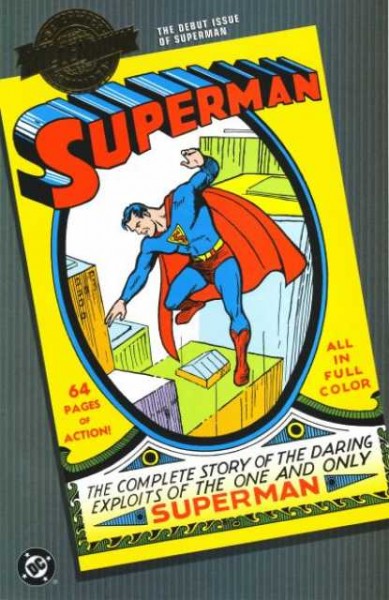
Superman No. 1, Millennium Edition, a reprint of the first ever Superman Comic.
This question was brought home to me as I picked up my son’s comic book. It’s a reproduction of the original Superman comic book from 1938 (Millennium Edition, Superman 1, December 2000, originally published as Superman No. 1 Summer 1939). Wow! It’s bad. Really.The characterization, the back story, indeed the characters are all pretty stale and cliched. But that’s my evaluation from this time, from 2014.
The reproduction starts with an introduction to the comic:
Until 1938 most comics were usually filled with reprint material spotlighting the more successful newspaper strips of the day. And while ACTION COMICS was one of the first titles filled with original material–created from scratch for less money than it would have cost to reprint existing comic strips–few could have been ready for the sensation its cover-featured star would cause! ACTION #1 spotlighted the debut performance of the world’s first–and still foremost–superhero: SUPERMAN!
This puts the fist story of Superman into context. No wonder there’s no mention of Jor-el and the struggle on Krypton (which is expounded in recent films). Mr. and Mrs. Kent are just described as an elderly couple. Clark’s first exploit is to prevent a lynching, then catch a singer who “rubbed out” her lover for cheating on her, and then to stop an incident of domestic violence. Not the stuff of super-fame. The stakes are low–Superman isn’t saving the world here.
But in the context of comics that just reprinted comic strips from the newspapers, Wow! Again, Wow! This was great stuff.
Two things strike me here: First, Superman had a humble beginning. Too often today, humble beginnings are overlooked or not allowed to even see the light of day. We want a fully developed story, with super-hero characters. But these type characters often need a small beginning. They develop over time as the story becomes part of the culture and join the conversations of our time. If the story captures any part of our imagination, they will become part of the conversation and the characters, the story, the plotlines–everything–will grow and develop. I wish there was a way to let more stories do this, to begin small, to join the conversations and to develop. Witness the Superman legends today, with rich back story on his parents, his struggles to fit into Earth, the dangers from other Kryptonite survivors, his love life with Lois Lane and so on.
Second, Superman was a product of 1938. His story joined the conversation of his time. His first act was to prevent a lynching. Would that speak to today’s audience? No. Domestic violence? Shrug. We’ve seen so many stories that are much better than the nine panels devoted to this small subplot.
How Does Your Story Join the Conversation
Today, werewolves and zombies are having a rich conversation in our culture. You’d have to be an ostrich to know nothing at all of the influx of werewolves stories. Well–if truth be told, I am almost an ostrich on these two subjects. Until I read Red Moon by Benjamin Percy, who brings the werewolf story alive in new ways. (Actually, I’m linking here to the audio version because the author narrates his own story in an impossibly deep voice that is fascinating to listen to.) This is no “Cry Wolf” story, but a fascinating look at how the ancient legend could possibly affect our lives today; and it’s told with impeccable prose that fascinated me with its amazing storytelling.
I shunned the whole zombie thing until my hairdresser raved about “Warm Bodies,” a movie that took Shakespeare’s Romeo and Juliet and updated it with zombies. Really? You could DO that? In other words, zombies were joining the conversation about romance and love. How do the things that separate men and women affect our lives? Can love really change things?
In other words, it’s almost impossible to live in today’s world and not know something about zombies and werewolves. The literary conversation is littered with these conversations that make connections which weave in and out of the canon of English and Western literature.
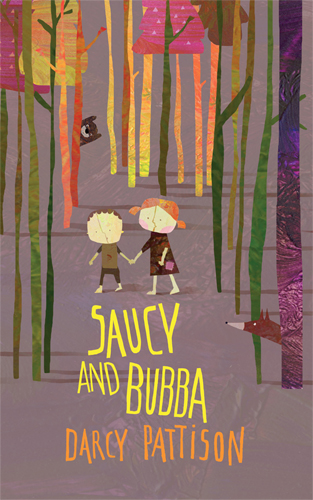
Saucy and Bubba. A Contemporary Hansel and Gretel Story.
I call my recent story,
SAUCY AND BUBBA, a contemporary Hansel and Gretel story because it puts it into a certain context: the discussion of step-mothers and how they treat the step-children. Mine is a twist on the old story–of course! In fact, it MUST be a twist on the old story, or it adds nothing to the conversation. Why would you rehash the same thing again. One reviewer said, “When a story can get me to even start to like the antagonist – like Saucy and Bubba does here – I know there’s a good book in my hands.” That’s what I wanted, a more nuanced look at the step-mother. I wanted the reader to have sympathy for her, even as they condemn her actions.
It’s like the original Superman comic: in today’s terms, it’s cliched. But it was hugely original for it’s time. It added to the conversations about justice and law-enforcement in interesting ways. If I simply repeated the Hansel and Gretel fairy tale, it would be a flop. Instead, we must think about how our stories fit into the context of our times. We must strive to join the conversation and to have something to add to the conversation. How can we add something different, interesting, conflicting, nuanced and so on? How are you enriching the conversation? How are you changing the conversation?
How does YOUR story join the conversation of our times?

My daughter’s name is Lara. It was one of the few female names my wife and I agreed on. I don’t remember who proposed it, but I know it was on the list I started in my early twenties. (Yes, I am that guy.) And I know my wife latched onto it after being swept up by Doctor Zhivago (which I still have not seen).
Though my wife might never believe me, and I can barely believe this myself, in deciding on the name for our baby girl, I did not remember that the name of Superman’s biological mother is Lara. In other words, I didn’t secretly propose/go along with the name because of my fondness for the Man of Steel.
My son’s name is Rafael. It was, I believe, the only male name my wife and I agreed on. (One of my first choices—Clark—was nixed even faster than I nixed one of her first choices…Fritz. Cut some slack. She’s German.)
I’m Jewish and because my wife is not, she gave her blessing for our son’s Hebrew name to be “Kal-El”—which is Superman’s Kryptonian name. Boys of Steel: The Creators of Superman was not yet out so my life was not yet so linked to Superman, but even then I felt going this route would be too fannish. I did not want our son—who may not care a whit about Superman—to be saddled with a Hebrew name he would not be able to say without a sigh.
So instead, we chose “Emet”—“truth” in Hebrew. (This was inspired by the motto of my alma mater, Brandeis University: “Truth even unto its innermost parts.”)
And just like I had a revelation only after naming our daughter, I had one with our son as well. I recently realized that, perhaps subconsciously, I did saddle him with a Superman name after all:
Rafa-El.
My friend Jamie Reigle is one of the world’s foremost collectors and purveyors of Superman memorabilia. I’ve mentioned him here before, and not only because he so kindly distributed hundreds (of the tens of thousands) of Boys of Steel: The Creators of Superman postcards over the years.
There were a lot:
In the summer of 2013, among the tributes acknowledging the 75th anniversary of Superman, the Cleveland Jewish News produced a special commemorative section; Jamie was profiled.
Mentioned and pictured: the page proofs of Boys of Steel signed by as many members of the Siegel and Shuster families as Jamie could round up.His sons are named Kalel and Lex. I trust Jamie has a plan to prevent young Lex from using his genius for evil…and I know I’m not the first to make that joke.
On 2/24/14, I had the honor of presenting at Gregory-Portland Intermediate School in Portland, TX (near Corpus Christi) for the second year in a row.
Another round of thanks to Cati (first syllable rhymes with “cat,” not “Kate”) Partridge for inviting me to speak with her students.
As before, the school (particularly library aide Cindy) created award-worthy displays to welcome me:Prop pay phone!
(I told Cati that there is no pressure to outdo themselves each time!)
And I had another honor this trip: I got to meet the genuine and articulate Ron Dennis, who is a friend of Cati’s and who is the grandson of Walter Dennis…who is a possible visual inspiration for Clark Kent.
I’d forgotten that I already knew of Walter; he is mentioned (and pictured!) in Superman: The Complete History.Superman: The Complete History by Les Daniels
Superman: The Complete History, page 19
Ron was kind to answer some questions:
INSERT
me with Clark Kent
me with Superman
By:
KidLitReviews,
on 9/14/2013
Blog:
Kid Lit Reviews
(
Login to Add to MyJacketFlap)
JacketFlap tags:
Children's Books,
Superman,
Batman,
children's book reviews,
board books,
Joe Shuster,
Jerry Siegel,
Picture Window Books,
DC Comics,
4stars,
Library Donated Books,
Bob Kane,
Capstone Publishing,
Donald Lemke & Ethen Beavers,
Add a tag
.. Superman Fights for Truth! (Dc Comics) by Donald Lemke & Ethen Beavers Picture Window Books 4 Stars .. About the Story: Someone has stolen from the grocer and it is up to Superman to catch the thief and returns the goods. Opening: Superman hears a cry for help. “Titano took my bananas!” yells a …
Only once in his lifetime, Bill Finger received a “written by” credit on a first-run Batman story, and it wasn’t a comic book.
And though he wrote Superman stories, too (he created Lana Lang!), same deal—one credit, in TV:
This is from The New Adventures of Superman, a Filmation series of animated shorts that debuted in 1966.
Though there is currently almost no trace online that Bill wrote for this series, in 2006, I did follow a path to determine that this was the case. But I didn’t look for the visual proof until now.Thank you to Bill Davis of Toronto for prompting me to revisit this.
Adios, Señor Superhombre.
Bonus:
Excerpts from emails with Bill’s second wife Lyn Simmons, and one other, in figuring this out:From: Marc Tyler Nobleman
To: Lyn Simmons
Sent: Saturday, October 14, 2006 9:02 AM
Subject: Hi Lyn - Superman movie
You said they called Bill to ask him to come to California to write a script for the Superman movie. I've talked with a few people who were involved with the film and they don't remember that. Are you sure?
There was another writer named Alfred Bester who was friends with Bill who was definitely asked—there are written accounts online. Did you know Alfred? Is it possible you're confusing the two? Can you remember any more details?
From: Lyn Simmons
Sent: Saturday, October 14, 2006 4:25 PM
good to hear from you marc. bester's name rings a bell but don't think i ever met him. i'm pretty sure that bill received invitation to ca to write superman films. it's so long ago and i could be mistaken but I don't think so. in any event he never went. he had anxiety about flying and about leaving nyc.
bill may never have told his fellow writers about ca because he didn't want to explain why he wasn't going.
From: Pierre Spengler
Sent: Wednesday, December 13, 2006 1:05 PM
We purchased the rights in november 1974 and therefore started hunting for writer in the beginning of 1975. Very soon thereafter we engaged Mario Puzo. Therefore we never approached Bill Finger.
From: Lyn Simmons
Date: Tuesday, December 19, 2006 10:18 AM
i believe he was asked to come out to ca in the late 60s. i'm pretty sure it was superman. maybe they wanted him out there for ideas or stories a year or so before he died which i think was in '74. but perhaps it was for cartoons.

By:
Heidi MacDonald,
on 9/11/2013
Blog:
PW -The Beat
(
Login to Add to MyJacketFlap)
JacketFlap tags:
News,
Reviews,
DC,
Superman,
Batman,
DC Comics,
Harley Quinn,
Top News,
Greg Pak,
Sterling Gates,
Jim Starlin,
Marv Wolfman,
Mr Freeze,
Neil Googe,
villain month,
Add a tag
We head into week two of Villains Month, with thirteen more titles out this week. Ranging from Harley Quinn and The Riddler through to Mongul and Black Manta, a theme seems to emerge this week – DON’T EVER GO INTO SPACE!
Follow the jump for every issue reviewed, from my least-favourite through to my favourite.
One thing that you should note is that some of the comics take place as part of Forever Evil – the Batman and Flash comics, it seems – whilst the Green Lantern/Superman issues are more general. So some issues follow on immediately from the first issue of the event, whilst others are more general stories. Keep that in mind as you buy the comics – they’ll all make sense, but some will be directly following on from the main story whilst others are unconnected origin stories.

Solomon Grundy
Matt Kindt (w), Aaron Lopresti (a), Art Thibert (i), Travis Lanham (l), Michael Atiyeh (c), Anthony Marques, Mike Cotton (e)
It feels like there’s a big missing section from this comic somewhere, which would help tie the two stories together. This is an origin story interweaved with a scene of Grundy causing chaos in the modern day, but the end of the comic leaves readers with a whole load of questions. The issue starts with the character crash-landing on Earth from outer space…. the origin sequence ends with Grundy being created, a hundred years ago, on Earth. So how did he end up in outer space, so he can subsequently crash back to Earth? No idea.
It’s a massively melodramatic story as well, veering almost immediately into complete manic camp – especially in the origin sequence, which is the craziest thing I’ve seen in a long time. It’s almost parody of itself. This is a bad comic, but at the same time? Enjoyable BECAUSE it’s so bad.

Brainiac
Tony Bedard (w), Pascal Alixe (a), Hi-Fi (c), John J. Hill (l), Rickey Purdin (e)
There’s a lot of horror in space this week, and Tony Bedard’s Brainiac story – although not really capturing the character’s intelligence – offers another imminent threat. Crucially though, I simply didn’t find any of what happened to be particularly interesting. Hi-Fi’s colours have picked a strange palette which makes every page into a fuzzy blur, like we’re watching an out-of-focus tv channel. Their decision muffles Pascal Alixe’s artwork significantly, and also seems to cause some real problems for the narrative. It’s quite hard to tell how some of the images relate to each other due to the colouring, especially when panels move around within a fixed space.
The story isn’t all that interesting either, explaining the duller parts of Brainiac without telling us anything about the cool bits – why don’t we get to find out the point of the pink disks he attaches to his head halfway through? What do those do, then?
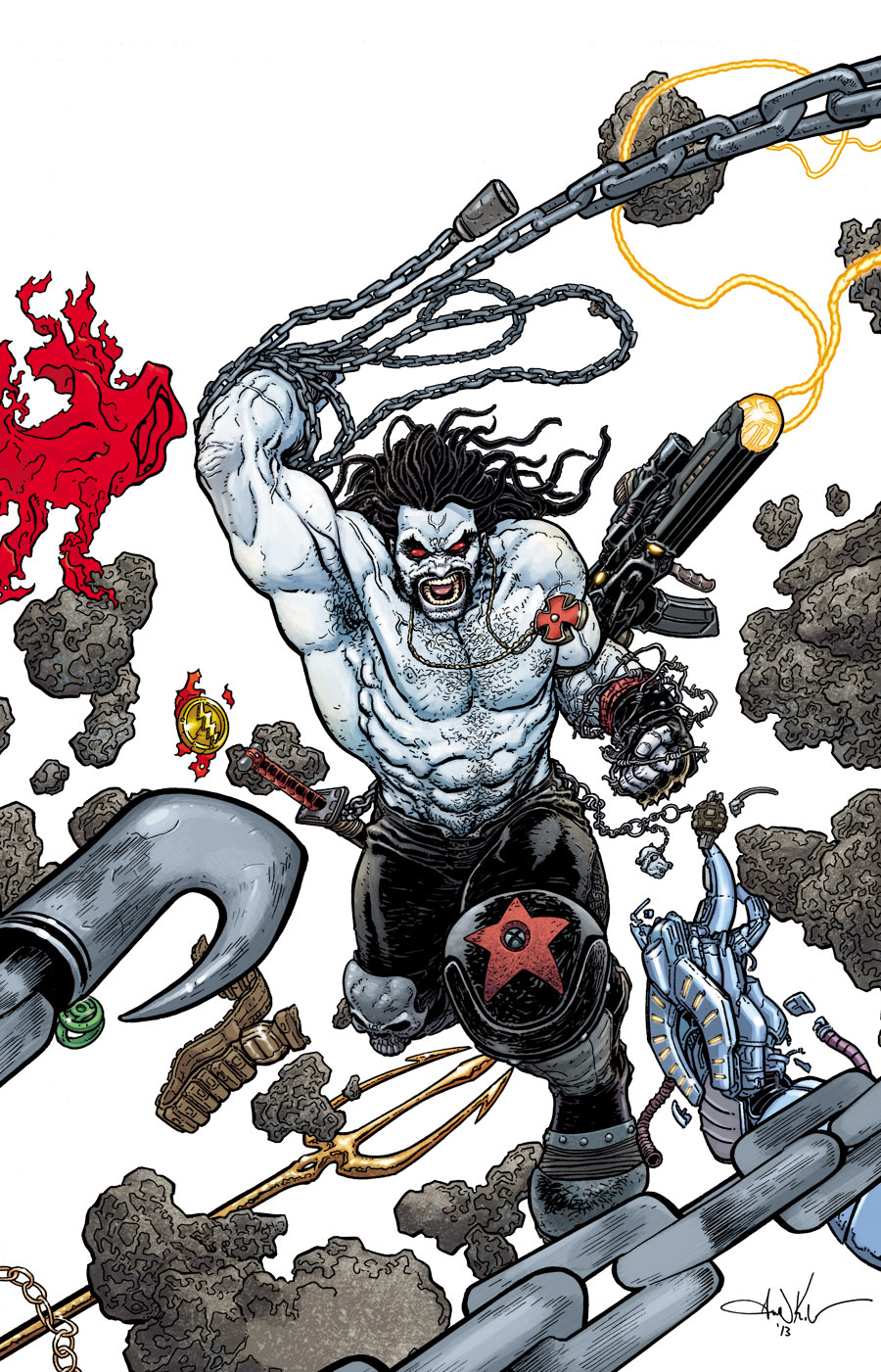
Lobo
Marguerite Bennett (w), Ben Oliver, Cliff Richards (a), Daniel Brown (c), Sal Ciprano (l), Rickey Purdin (e)
I didn’t understand the ‘controversy’ about this issue, but the story itself doesn’t really help endear this new character to readers. Despite Simon Bisley’s Lobo on the front cover, the character doesn’t make an appearance anywhere in the story. This is, instead, about a younger, sleeker Lobo who speaks in the same way (Bennett’s script absolutely nails the dialogue) but doesn’t really get much of a chance to shock the reader. The story is slow and doesn’t go anywhere, and the whole point of Lobo, surely, is that he does outrageous and over-the-top things – this issue doesn’t give readers any of that craziness.
It’s not a bad comic, but it’s nowhere near as dynamic and enjoyable ridiculous as a Lobo story should be.
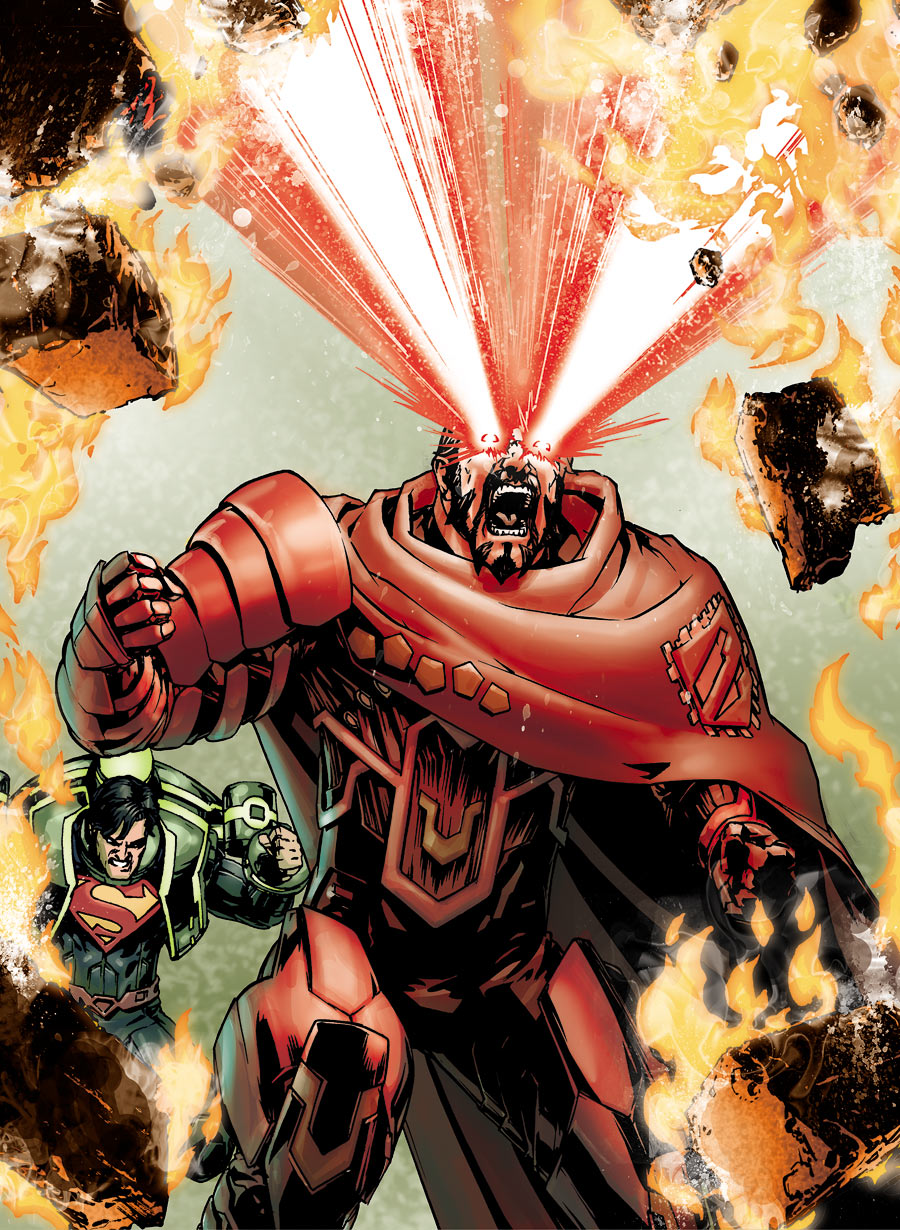
Zod
Greg Pak (w), Ken Lashley (a), Steve Wands (l), Pete Pantazis (c), Anthony Marques (e)
There’s a miniseries hidden inside an issue here, with Zod a character who has a lengthy backstory which struggles to be crammed inside a single issue. The main concern with this issue is that Pak simply can’t get the whole story into this issue, leaving us with an issue which leaps around in time and sequencing almost as random, leaving readers slightly confused as to what’s happening. Ken Lashley’s artwork manages to do some heroic efforts in this regard, however, establishing the alien world Zod surrounds himself in as a really bizarre, weird place to live in.
Lashley seems to be the perfect fit for an outer-space story, as he manages to design around five different outfits for Zod (like I say, the story races through time like a dervish) which all seem appropriate to his place in Krypton’s society and his role as a constant outsider to it. If this had been expanded into a longer piece of work, it could have made for an interesting tale. As it is, this is a story which is constantly rushing forward, and the reader falls behind sooner rather than later.

Trigon
Marv Wolfman (w), Cafu (a), Jason Wright (c), Steve Wands (l), Anthony Marques, Mike Cotton (e)
Marv Wolfman returns to a character he co-created and gives him an utterly horrific backstory and motivation which I presume will be setting up some future storyline in Teen Titans. This wasn’t a bad issue by any means – almost every issue this week seemed fine, at the very least – but it is a bit reliant on the central shock value of the character’s actions. If you strip out the villainy, I’m not sure I really felt a true sense of what the character’s ambitions are beyond ‘be horrible’.
Cafu and Jason Wright offer some brilliantly realised artwork, however – Wright’s colouring is especially fantastic, and ensures that this isn’t an issue which looks as grimy and dirty as it reads. There’s a brightness and vibrancy in the colouring which takes the character and makes him seem more impressive and powerful. The secondary characters are all muted, leaving Trigon the brightest character on each page.

Harley Quinn
Matt Kindt (w), Neil Googe (a), Wil Quintana (c), Taylor Esposito (l), Harvey Richards, Will Moss (e)
Remember how Harley Quinn is a terrible person wrapped up in a sweet and adorable harlequin bow? Matt Kindt’s issue reminds you that within that candy coating beats an evil, evil person. Struggling a little to connect the two halves of her personality to each, Kindt’s script eventually resorts to having the two narratives in her head shout at each other – which actually seems to fit her pretty well. This is a madcap issue, running at a very quick speed thanks to Neil Googe’s utterly wonderful artwork.
Googe steals the issue, in fact, emphasising the utter horror of Harley’s power fantasies during a particularly grim, extended joke sequence in which she acquires her new costume. There’s an overwhelming presence of character on the pages of the issue and it’s very good fun, even if it is rather aimlessly. The final page is a mega disappointment in that regard – it puts her back to square one for the New 52.
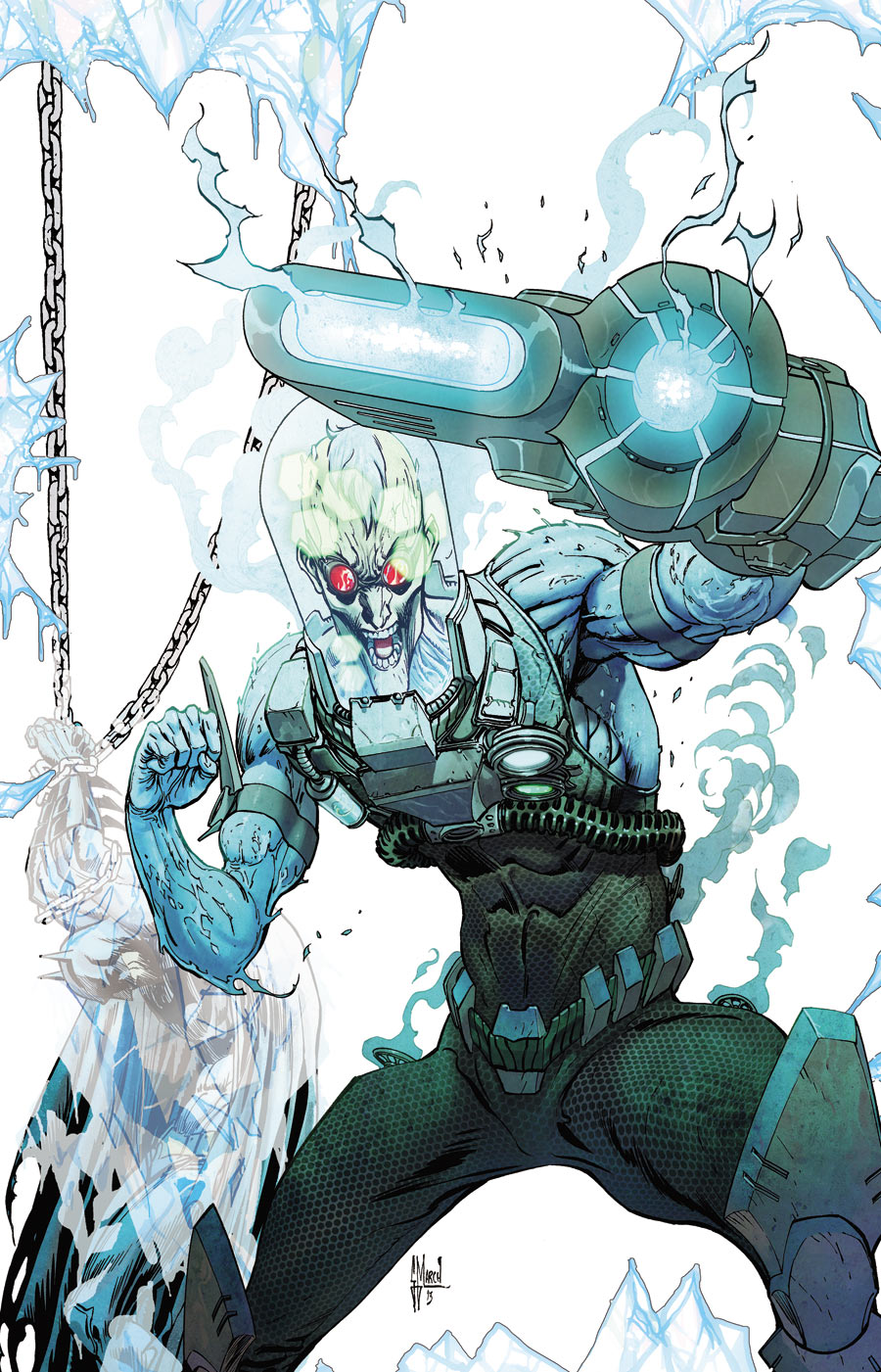
Mr Freeze
Jimmy Palmiotti, Justin Gray (w), Jason Masters (a), Dave McCaig (c), Jared K. Fletcher (l), Darren Shan, Rachel Gluckstern (e)
Mr Freeze has gone through an interesting development during the New 52, in that Scott Snyder invalidated the whole ‘dead wife tragedy’ aspect in the character. With Nora now a distant memory, Palmiotti and Gray are left with the task of finding a new thing for the character to fixate on. That they magae to do so may well be the greatest triumph of the New 52 thus far.
The character was so heavily motivated by a need to protect his wife that a more straightforward villainous agenda feels beneath him, but the creative team here do their very best to work on the character and make this new aspect work. Their tactic is to make him so amoral and unfeeling as to be completely unpredictable, and McCaig’s colours assist this greatly. The bright red goggles, the only dynamic feature of Freeze, hide his eyes for the entire issue – a very effective tactic. It’s a solid issue.

Mongul
Jim Starlin (w), Howard Porter (a), Hi-Fi (c), Carlos M. Mangual (l), Kyle Andrukiewicz, Joey Cavalieri (e)
An excellent reimagining for the character which realises the original design doesn’t really need to be changed. The last I saw of Mongul, he had one eye and was terrorising the Green Lantern Corps. Here, though, the New 52 reimagines him as a military genius, living on a massive spaceship the size of a planet and defeating every force in his wya.
Starlin writes the issue as a celebratory monologue from the character, as he takes his latest defeated foe for a tour round his house and gloats about how easy victory is for him. On a character level, we now have a great sense of what Mongul is like and how his mind works. Starlin’s script is tight, but still allows the character to show himself off repeatedly; aided by some of the best art I’ve seen from Howard Porter, whose style usually puts me off.
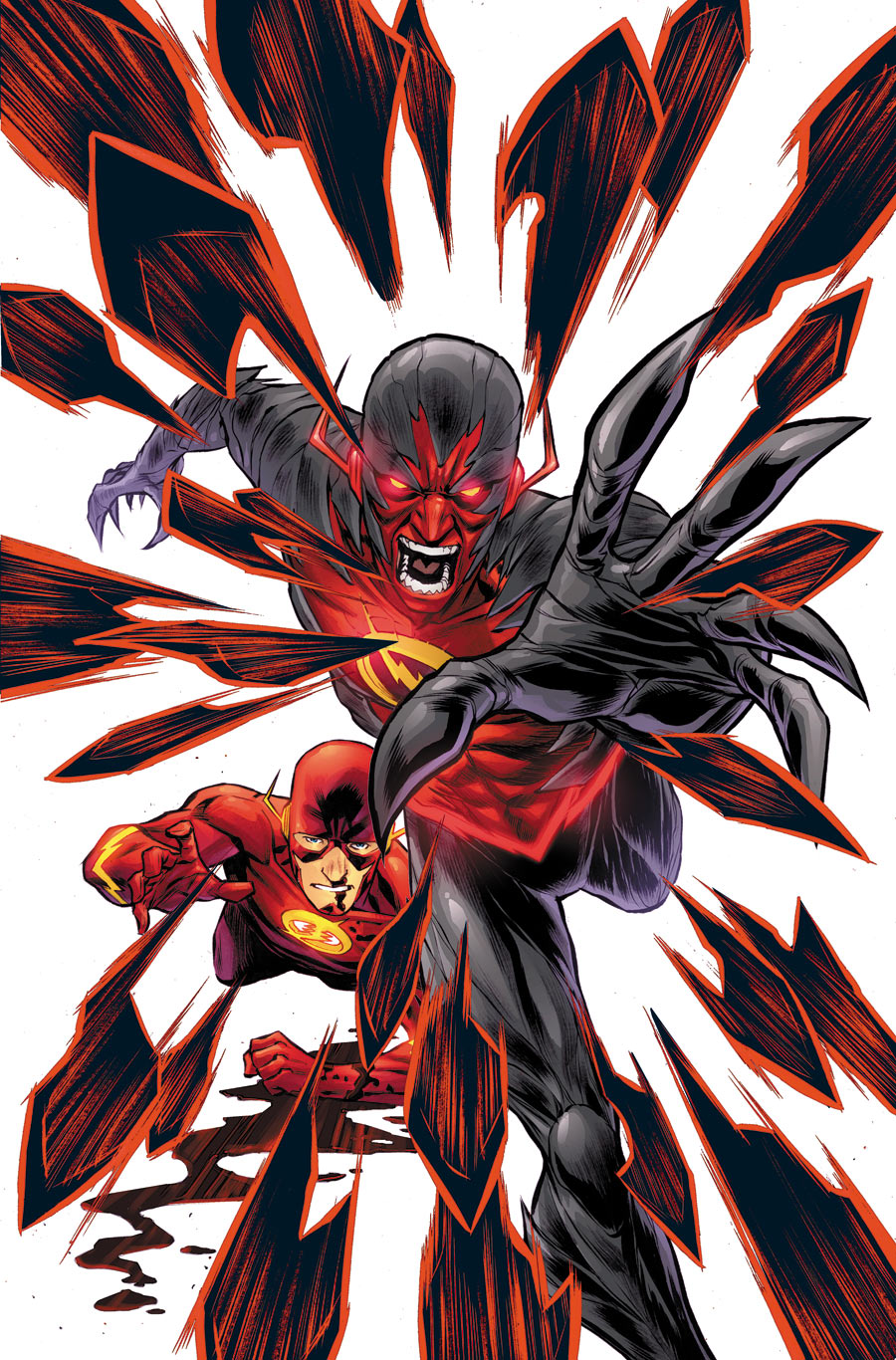
Reverse Flash
Francis Manapul, Brian Buccellato (w), Scott Hepburn (a), Buccellato (c), Carlos M. Mangual (l), Harvey Richards, Will Moss (e)
It wasn’t until the last page that I realised this wasn’t an issue DRAWN by Manapul, but was instead the work of Scott Hepburn. Coloured by Buccellato, Hepburn hurls himself wholly into this issue, producing some dynamic and wonderful pages with a zip and pace only Manapul himself could match. For the most part, this is an issue featuring the Reverse Flash as a regular person, and the pages reflect that with a blocky style. But whenever he transforms? Suddenly the pages explode apart with zagged borders and fractured panels.
It’s a fantastic showcase for Hepburn. As far as story – this is okay. It gets the idea across of the main character, but in doing so it accidentally breaks one of the supporting characters. By establishing Reverse Flash as a sympathetic figure, it has to make his sister – Iris, perhaps you’ve heard of her – seem rather cruel. I didn’t buy that, particularly. As this is, however, essentially an advert/prelude to the next big arc on The Flash, perhaps the team will be able to sort that out later.

Court of Owls
James Tynion IV (w), Jorge Lucas (a), Dave McCaig (c), Steve Wands (l), Katie Kubert (e)
A paranoia thriller of a one-shot, here James Tynion IV lets loose with the conspiracy angle of the Court of Owls and manages to just-about put their ship back on water. Which is a strange metaphor to use, but I’ve written ten reviews about villains already and my mind hurts. The Court of Owls were an interesting idea which didn’t quite hit the target during Scott Snyder’s original story, but here Tynion manages to get the concept together and make it seem plausible that they would exist.
Jorge Lucas and Dave McCaig nail the issue, absolutely. Coupled with the disturbing white-on-black lettering from Wands, the issue manages to create an investing and fascinating tonal style which gives the concept of a secret society in Gotham a feeling of realism. There is one panel where Lucas misses this mark and creates an unintentionally funny moment, but overall this is an engaging issue.
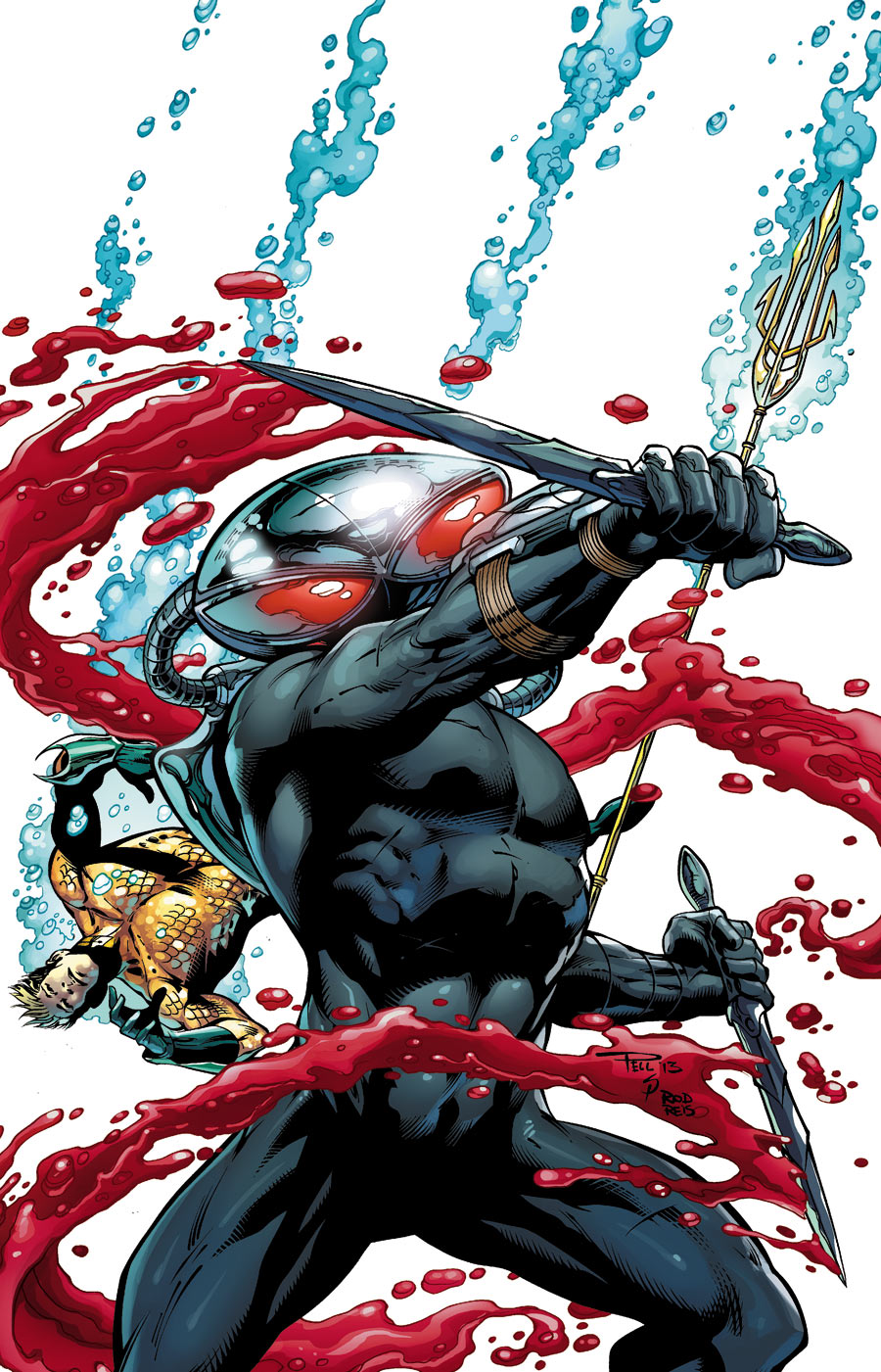
Black Manta
Geoff Johns, Tony Bedard (w), Claude St. Aubin (a,/i), Blond (c), Carlos M. Mangual, Taylor Esposito (l), Kate Stewart, Brian Cunningham (e)
The most interesting aspect of Forever Evil is undoubtedly that several of the villains seem to have immediate plans to overthrow the Society of Super Villains and go their own way. This is once more the case with Black Manta, and the character seems primed for an interesting future following this issue.
Following Geoff Johns’ plot, Tony Bedard quickly sketches the basics of the character’s personality despite the book being heavily connected to Forever Evil. At least half the issue is working through the events of Forever Evil #1 from Manta’s perspective, expanding his role and motivations within a narrative we’ve already seen unfold. As a result, this is an issue which requires the reader to have seen the main event in order to get the most out of it. But, if you have, what follows is a surprisingly effective character issue.
The bulk of this story is based around the enmity between Black Manta and Aquaman, which makes one scene towards the end particularly effective – where Manta has the choice between two objects, and picks one over the other. It may be a little slight, but Black Manta is a quick and fun piece of the Forever Evil storyline, and shines a spotlight on a character who has seen significant growth over the last year.
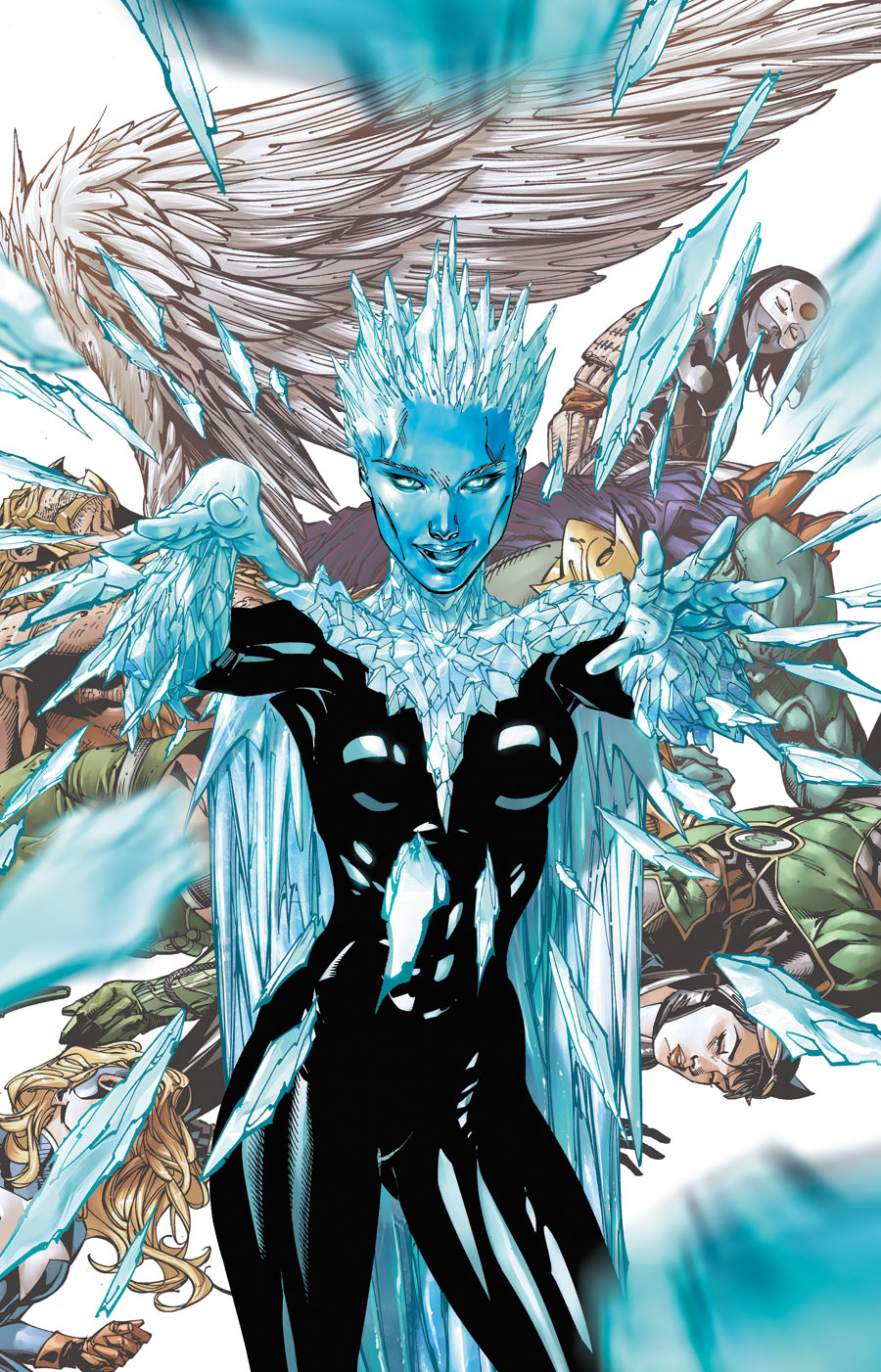
Killer Frost
Sterling Gates (w), Derlis Santacruz (a), Brett Smith (c), Dave Sharpe (l), Kate Stewart, Brian Cunningham (e)
Killer Frost is a proper done-in-one horror story which then trails into the DC Universe right at the end, and is all the better for it. If Villains Month is proving anything, it’s that a lot of American writers struggle to create a proper done-in-one issue. Killer Frost – and the final issue of this month – are perhaps the two best exceptions to that rule, thus far. Sterling Gates and Derlis Santacruz take a note right out of Whiteout and The Thing, by stranding the central character in an Arctic Colony where people are acting suspiciously.
The majority of the issue is spent with her before she becomes a super-powered villainess, and as a result we get a real feel of her and her motivations, making her a sympathetic protagonist. When things go wrong, we get to experience John Carpenter-in-reverse, with Santacruz offering some exceptional suspense work which shows just enough of the violence to get the concept across – without ever showing so much that the comic feels gratuitous.
And when the issue moves into the DC Universe proper, Gates reconnects the character with her most well-known opponent, but adds a new wrinkle to their enmity which again serves her brilliantly. I knew nothing of the character before – now I’m excited to see where she moves next.

Riddler
Scott Snyder, Ray Fawkes (w), Jeremy Haun (a), John Rausch (c), Taylor Esposito (l), Katie Kubert (e)
The Riddler finally gets a showstopping sense of definition at DC, as Scott Snyder and Ray Fawkes take the character and evolve him into a fully-formed, unpredictable theorist. Creating several rather clever riddles (I only guessed two out of five) and leaving them on the first page of the issue, readers are then asked to work out how these five riddles are going to allow the character to complete his goal of breaking into Wayne Tower.
This is gripping stuff, with Haun’s artwork methodically detailing the character’s movements and body language. There’s a moment where the character plays golf halfway through the issue which is a brilliantly quirky detail, and demonstrates just what makes him so fun to root for. There’s a playfulness in this violent and mentally ill supergenius, and Fawkes’ script allows the character several interesting new tics and ideas. Riddler comes off as evil, but in a way which suits his high intelligence levels – he’s a bag of tics and fears and arrogance, shaken up and then let loose into the world.
Taylor Esposito’s lettering is a great asset to the story also. If the reveal of each riddle weren’t placed as perfectly as Esposito places them here, the issue would fall flat, regardless of the great script, art, and colouring. Esposito carefully works out how to set up each page, creating a seamless reading experience for the reader. It’s really a tremendous issue. I’m biased because I have a previous love for the character… but this issue took everything I like about him and made it sing.
Here are the numbers:
* four books directly follow from Forever Evil – including all the Batman books, aside from The Court of Owls.
* eight have no connection to Forever Evil whatsoever
* there is no origin story for Lobo or The Riddler
* Batman created by Bob Kane, Court of Owls created by Scott Snyder/Greg Capullo, Aquaman created by Paul Norris, Mongul created by Len Win/Jim Starlin, Harley Quinn created by Paul Dini/Bruce Timm, Superman created by Jerry Siegel/Joe Shuster, Lobo created by Roger Slifer/Keith Giffen, Trigon created by Marv Wolfman/George Perez

By:
Heidi MacDonald,
on 9/4/2013
Blog:
PW -The Beat
(
Login to Add to MyJacketFlap)
JacketFlap tags:
Jeff Lemire,
DC Comics,
Green Arrow,
Gail Simone,
Top News,
Guillem March,
Greg Pak,
Andrea Sorrentino,
andy kubert,
Darkseid,
Derek Fridolfs,
Superman,
Poison Ivy,
The Joker,
Villains Month,
News,
Reviews,
DC,
Add a tag
DC sent along a lovely pack of review copies for Villains Week, and I feel like it’s only fair that I read through all of the ones out this week and review ‘em. I’ll go from my least favourite to my favourite, ending with my favourite of this first lot. And hey! If DC send along a second selection next week, I’ll review those ones too!
Slight spoilers below, but nothing particular.
One thing that you should note is that some of the comics take place as part of Forever Evil – the Batman and Flash comics, it seems – whilst the Green Lantern/Superman issues are more general. So if you pick up Poison Ivy or Grodd, it’ll make reference to two of the more immediate moments which occur in Forever Evil #1. Keep that in mind as you buy the comics – they’ll all make sense, but some will be directly following on from the main story whilst others are unconnected origin stories.

Desaad
Paul Levitz (w), Yildiray Cinar (a), Jason Wright (c), Carlos M. Mangual (l), Anthony Marques, Mike Cotton (e)
I’m astonished this issue was made. Impossible to understand as a standalone story, it features a sequence about a mass shooting which is in extremely poor taste. The rest of the comic doesn’t explain who Desaad is or what’s going on, and is filled with concepts and ideas which are neither fleshed out nor coherent. The art tells the story – what little there is – well enough, but there are some dodgy character designs going on. I didn’t care at all about Desaad by the end of the issue.

Relic
Robert Venditti (w), Rags Morales (a/i), Cam Smith (i), Andrew Dahlhouse (c), Dave Sharpe (l), Chris Conroy (e)
There’s an interesting story in here somewhere, but the artistic choice made here turns an origin story into a complete chore to read. Every page is a splash page from Rags Morales, and he chooses some absolute clunkers. The first page shows a pretty galaxy with an arm floating into the left frame. What’s going on? Who knows. It’s boring.
Morales doesn’t make any of the concepts in Venditti’s script work, and his character designs are uninspired and uniform. Andrew Dahlhouse does his absolute best to clean up this mess, but it’s a lost cause. I can see that Venditti’s story would be interesting, if only the comic had been told sequentially instead of as a series of misconnected splash pages.
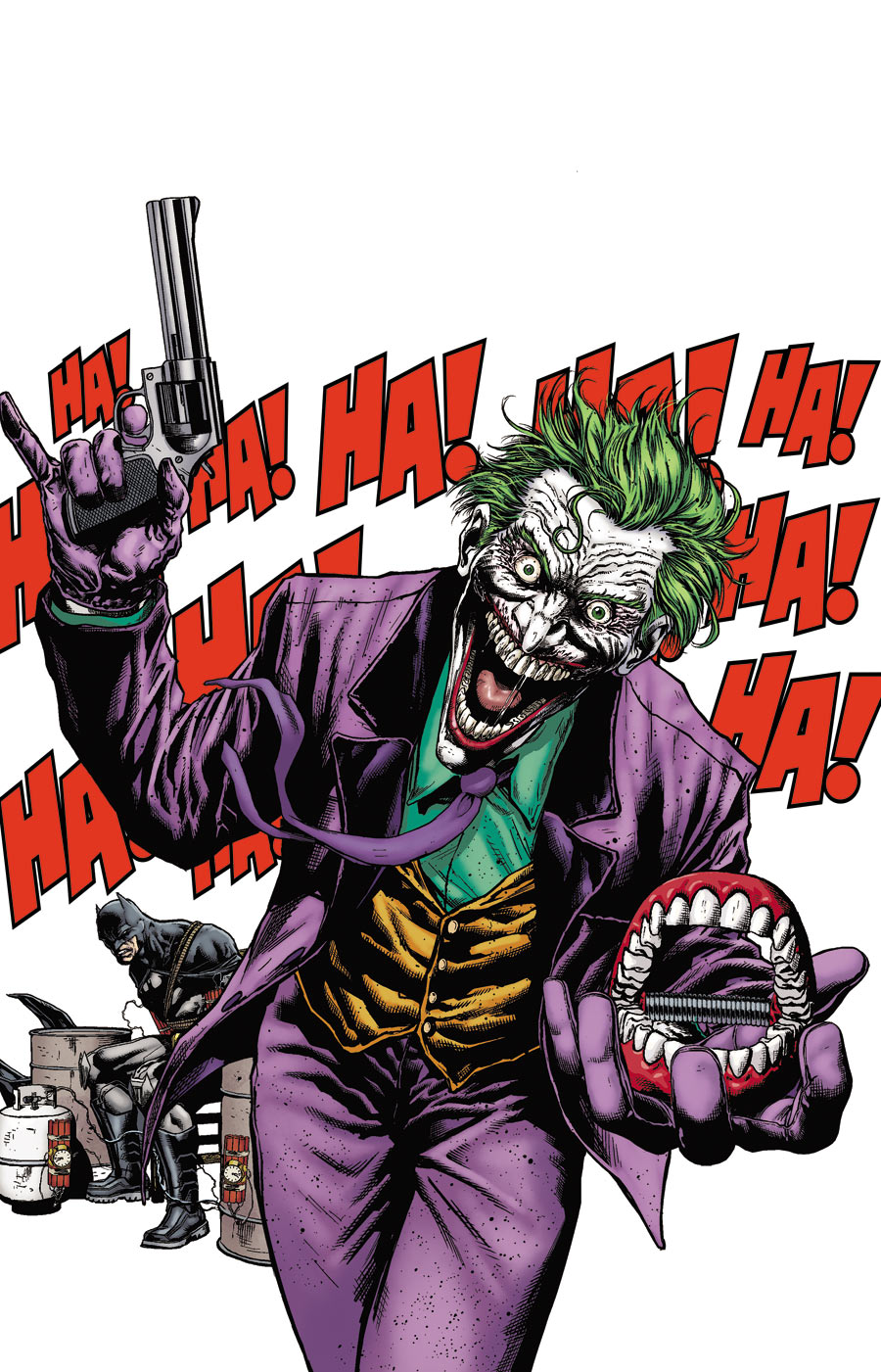
Joker
Andy Kubert (w), Andy Clarke (a), Blond (c), Jared K. Fletcher (l), Katie Kubert (e)
As you might expect, there’s really no reason to try and offer any backstory to The Joker. This issue tells a nonsense side-story from some point in Joker’s past, during which he has some flashbacks to his childhood. Really, any attempt to flesh out the past of the character is always going to flop – the more we know about Joker, the less interesting he is. As a result, the issue flails with an un-involving main story which bombs the final gag, and flashbacks which take away from the story entirely.
Andy Clarke’s artwork is lovely, as always, although the weak script means it’s very difficult to determine how some scenes are meant to be interpreted. There looks to be some intent at offering a subtext, but this is only conveyed in the art and not the script. It seems as though one of the supporting characters is secretly working at a cross-purposes, but there’s only so much the art can do without clear dialogue. Clarke attempts to elevate a completely throwaway storyline, but can only offer a very pretty, very weak, story.

Grodd
Brian Buccellato (w), Chris Batista (a), Tom Nguyen (i), Wes Dzioba (c), Wes Abbott (l), Kyle Andrukiewicz, Joey Cavalieri (e)
Grodd’s a curious character. The main reason he exists as a villain is because gorillas are scary, I guess? This is an issue which struggles because the character comes into this issue with a goal that doesn’t make any sense. Every single character in the comic calls him out for his strange decisions and ambition, and he basically hits them until they give up trying. Does it forgive a strange character if every other character CALLS him strange? I’m not sure on that.
Chris Batista, to me, is one of those artists DC have never appreciated quite enough, and his work here is really good fun – not everybody can draw an expressive gorilla. Not a bad issue by any means, but one which doesn’t manage to quite fix the character.

Cyborg Superman
Michael Alan Nelson (w), Mike Hawthorne (a), Daniel Brown (c), Carlos M. Mangual (l), Rickey Purdin (e)
Interesting, this one. It’s going to upset fans of the character, but tells a reasonably involving story. Framing two sequences against one another, the final few twists are very obvious, although Nelson mines from really fun laughs from Cyborg Superman’s sadistic quest for a sidekick. I don’t know how this actually fits in with established continuity – it would seem to wreck Green Lantern’s past storylines, for example – but we’ll have to see. It’s a perfectly fine comic, and Hawthorne’s art is like somebody put Jamie McKelvie and Stuart Immonen’s art in a blender. Good, in other words.
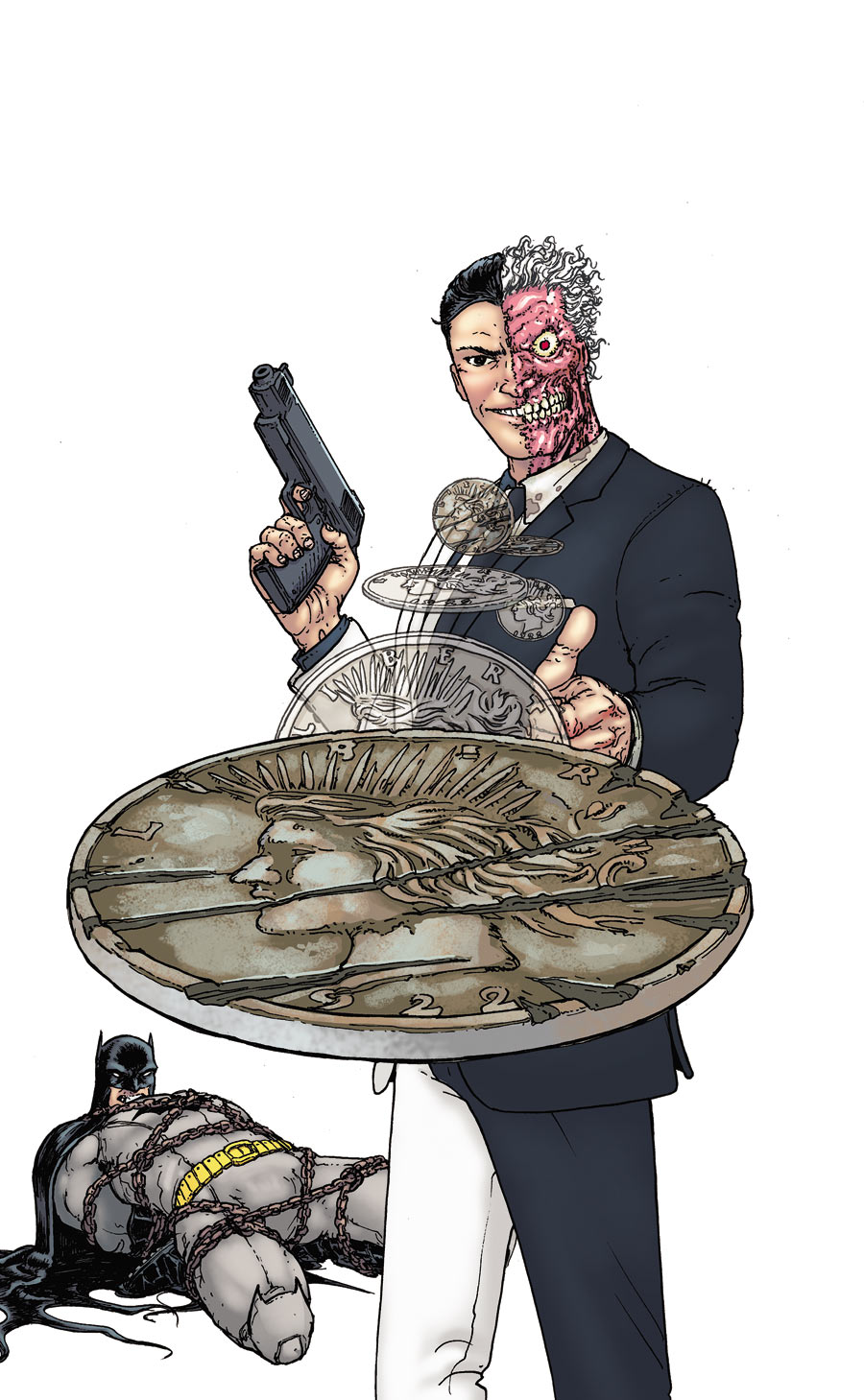
Two Face
Peter J. Tomasi (w), Guillem March (a), Tomeu Morey (c), Dezi Sienty (l), Darren Shan, Rachel Gluckstern (e)
Featuring an astonishingly drawn and coloured opening sequence between Two Face and Scarecrow whilst both are stood ON the Bat-Signal, the issue sadly then moves into familiar territory for the rest of the issue. Morey’s colouring is spectacular though, especially in the early stages of the issue. At first it feels like there’s a definite plan for the issue, until the story turns into a typical Two Face/anti-hero narrative. There’s nothing especially new here, especially for those who have read No Man’s Land and other stories where Two Face similarly has no Batman opposing him.
It’s entertaining, but it also feels like Tomasi is killing time for the last half of the page-count. There’s some good puns about duality, though, which is half the battle in a Two Face story.
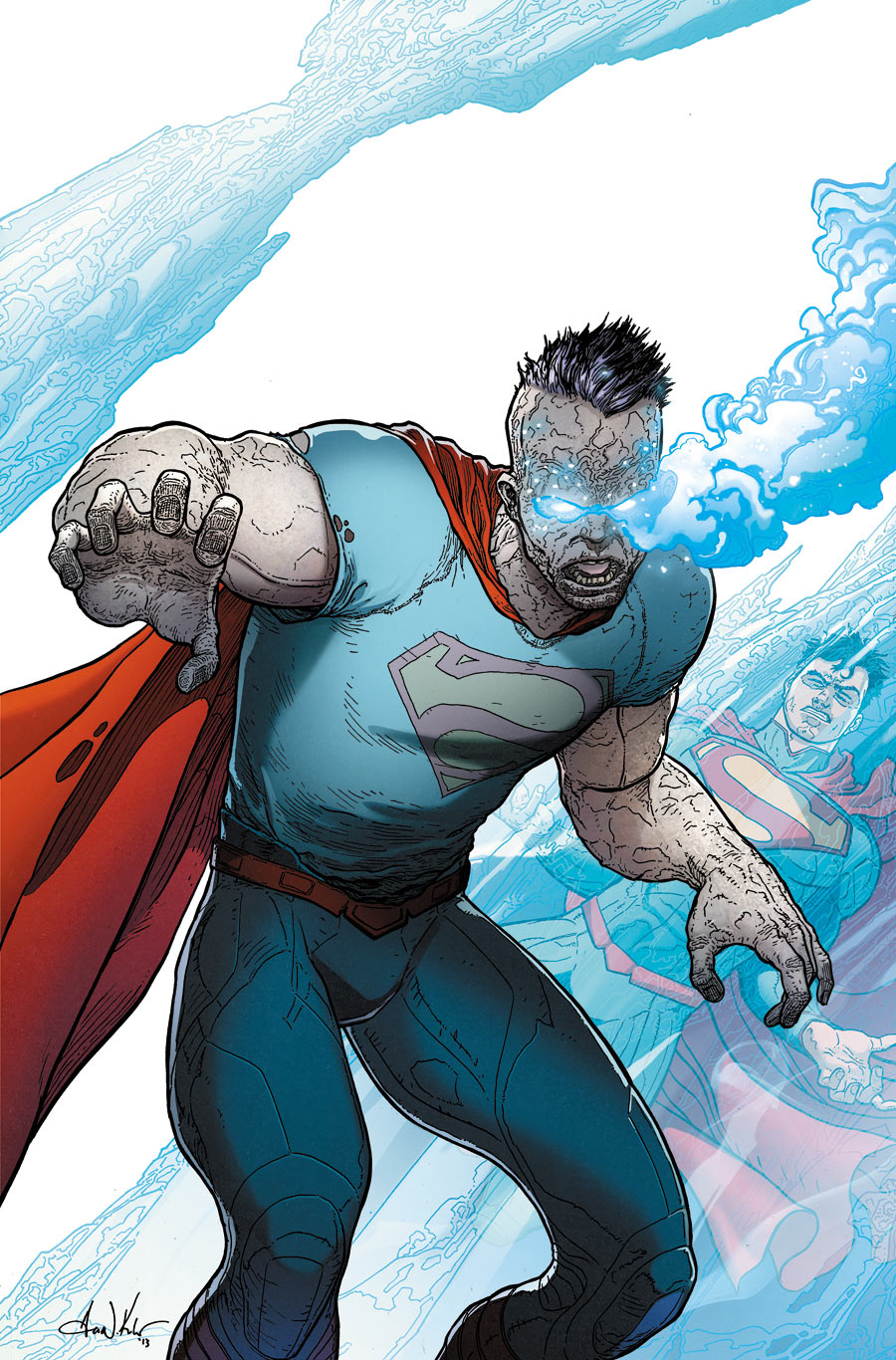
Bizarro Superman
Sholly Fisch (w), Jeff Johnson (a), Andy Smith (i), Javier Mena, Jordie Bellaire (c), John J. Hill (l), Ricky Purdin (e)
This is actually a Lex Luthor story, and it follows familiar ground in an entertaining way. No other character in comics quite has that mix of ambition, arrogance and disregard that Luthor has, and Fisch nails the character. Bizarro Superman himself is a strange creature in the comic – his arc is obvious from the moment he appears. Interestingly enough, Bizarro at no point takes on the design he has in the cover – this is a step far removed from the ‘classic’ rendition of the character.
But despite the by-numbers nature of the narrative, the creative team fit enough touches of silliness and character into the story that the comic works very nicely indeed. I was surprised to find I enjoyed the comic so much, but it was a really solid issue.

Ventriloquist
Gail Simone (w), Derlis Santacruz (a), Karl Kesel (i), Brett Smith (c), Dave Sharpe (l), Katie Kubert (e)
Very much in-tone with her run on Suicide Squad, Gail Simone’s story here puts focus on different mindsets of villainy. One thing the writer has excelled at recently has been creating villains who do evil acts no other villain would do – her Deadshot felt like a unique person rather than a sarcastic goon with a gun, and she’s created some of the most genuinely unsettling villains of the last few years. So it is again with Ventriloquist, which focuses on the second iteration of the villain, Shauna Belzer.
Carefully told, even if it does require a rather large suspension of disbelief towards the end, the story gives us a version of the characters – both ventriloquist and dummy – which keeps readers surprised and unprepared for what might happen next. And when Simone does leave a blatant piece of foreshadowing in the story, she does it to drum up tension and let readers stay one step ahead of the characters. It’s a well-done story, which takes an (probably rightfully) underused villain and give them a bit of purpose and character. It might be deeply silly, but there’s a deadly slice of horror tucked away in there too.

Count Vertigo
Jeff Lemire (w), Andrea Sorrentino (a), Marcelo Maiolo (c), Rob Leigh (l), Harvey Richards, Will Moss (e)
A considered and underplayed issue, Green Arrow’s team make the most of this opportunity to build up one of the character’s most famous villains. Despite a slightly silly design, the character gets a much-needed redevelopment and sense of purpose which feels genuinely menacing. This doesn’t feel like a villain who is insane, but rather a methodical and calculated man who realises that breaking a moral code is preferable to getting left behind.
Sorrentino and Maiolo do some more wonderful work on the issue, continuing their incredible run of form. Sorrentino is the most distinctive and impressive artist at DC, and creates a wonderful sense of space in his work. On one page, for example, he breaks the story into ten page-width boxes, but without any of them feeling cramped on unintelligible. He does masterful work with POV framing, as well – he has an innate sense of perspective which makes it feel as though we’re looking directly out the eyes of the character, without things seeming like they’re overly-crafted and false.
It’s a very very strong issue indeed. Lemire unfolds an inevitable story as his own leisure, and leaves us with the indelible impression that Count Vertigo just became one of DC’s finest.

Poison Ivy
Derek Fridolfs (w), Javier Pina (a), John Calisz (c), Taylor Esposito (l), Kyle Andrukiewicz, Joey Cavalieri (e)
Like with the Two Face issue, this is an exploration in what Poison Ivy does when Batman isn’t around. And again, it’s basically what happened in No Man’s Land. The creative team manage to spread that idea out, however, and fill in some great details about the character and her origin. Also, there’s something quite enjoyable about seeing the character cut loose and have fun, because unlike most other Batman villains, her goal is philanthropically sociopathic. Fridolfs details how her ambitions are almost-so-close to being understandable, and Kalisz’ colours actually go a long way towards aiding that.
In the flashback sequences his colours highlight the character as a total innocent, in bright, warm pastels which makes the reader feel empathetic to her. Pina’s artwork is also excellent, presenting the character over the years as she ages – young and adult Ivy look like each other. I have a soft spot for the character, but the issue doesn’t rest on that hope. Instead, it offers a coherent origin story which binds the character’s personality together and leaves her in a stronger position than before.

Darkseid
Greg Pak (w), Paulo Siquiera, Netho Diaz (a), Hi-Fi (c), Dezi Sienty (l), Anthony Marques, Eddie Berganza (e)
The best issue so far, and likely to be the best of the initiative in general. Greg Pak offers us a talking Darkseid who earns his position as villain #1 in the DC universe. He’s scary and performs crazy, ambitious feats. What’s most notable is how Pak seeds his own just-started stories into the first Justice League story Geoff Johns wrote in the New 52 – it feels seamless and goes a very long way in fixing the problems many readers had with that first story.
A brilliant showcase for Darkseid as a villain, the issue is big and grandiose, explains who he is and why he does what he does, and makes the reader eager to read more Darkseid stories in future.
As I mentioned it in the Joker review, I should also mention it here – it’s a bit strange reading a Darkseid origin story. At the same time, so far in the New 52 Darkseid has been a bit rubbish… so I’m really just happy that the issue deals with him, gets it out the way and pushes the whole thing forwards.
Siquera, Diaz and Hi-Fi offer distinctive, eye-popping visual images whilst letterer Dezi Sienty handles the Kirby-esque dialogue with consummate ease. The ideas presented here could look silly and ridiculous, but for the intervention of Siquira and Diaz as artists. They handle everything thrown at them and turn it from nonsense into a believable (if strained) reality. If there’s one villain issue to pick up – it’s this one, for my money.
And here’s some numbers:
* five of the books are origin stories set primarily in the past
* six are set in the ‘present’ day, after Forever Evil #1
* three of them do not feature the ‘origin’ of the character profiled
* two books have a completely different character in the starring role, rather than the original pre-52 character
* four of the characters have a backstory of familial abuse/murder
* Batman, Superman, Darkseid, Count Vertigo, The Cyborg (Superman) and Desaad all get ‘created by’ credits.
My second time in Tennessee took me to two schools in one day and the Knoxville Children’s Festival of Reading the next day.
The first school was a Jewish day school, where the setup enabled me to take this photo of two symbols which, to me, each speak of peace:The other school was an Episcopal day school, so it was a day of unity.
The festival was the morning after rain, and held on a field, which had turned to grassy muck, which meant the one pair of shoes I brought was the wrong pair of shoes. Luckily, that was the only downside; the crowds were fun, I received a special gift, and I sat on a panel with people whose work I admire. Deborah Diesen, Bob Shea, Jarrett Krosoczka,
Sudipta Bardhan-Quallen, me
During that panel, a girl in the audience asked us a question I found profound: how do we as adults relate to the kids we write for? I wish I could say my answer was that I stuck out my tongue, but it was not that clever. Whatever I did stammer out was heartfelt, but still a real missed opportunity on that one.
If you have ever wondered what a panel of authors looks like the night before the panel, mystery solved:
The love theme from the 70's version of Superman came up this week. Made me nostalgic...
(sung by Maureen McGovern).
In October 2012, Cleveland, the city in which Superman was created, installed an exhibit about him in the airport.
In June 2013, Kansas, the state in which Superman crash-landed, will induct him (as well as Clark Kent) into its hall of fame.
What is your city doing to celebrate the 75th anniversary of the world’s first superhero?
A week that brought horror in Boston and shame in Washington also includes an unlikely positive: according to court records, it was 75 years ago today when Superman debuted in Action Comics #1.
Thanks to the Boys of Steel for changing everything, even still: this month inaugurates an (admittedly clunky) tweak to the credit line in Superman stories: from Justice League #19 (first appeared in Action Comics #19, 4/3/13)
If you think it trivializes real-life struggles to juxtapose them with a fictional character, go back to 1938: when America was caught between two of its greatest challenges (the Depression and WWII), Superman brought hope literally to millions...
It couldn't hurt to give the sky more than a passing glance today.

By:
Heidi MacDonald,
on 3/30/2013
Blog:
PW -The Beat
(
Login to Add to MyJacketFlap)
JacketFlap tags:
Wonder Woman,
Marvel Comics,
archetypes,
WonderCon,
DC Comics,
Green Lantern,
Mark Waid,
Green Arrow,
Dan Slott,
Top News,
Doug Mahnke,
Katana,
Ann Nocenti,
Cat Woman,
J. M. De Matteis,
Michele Brittany,
News,
Events,
Comics,
DC,
Marvel,
Conventions,
Superman,
Icons,
Batman,
panels,
Add a tag
A panel on Friday, March 29th, the first day of programming at WonderCon brought together a rather iconic cast to discuss “iconic characters” and what keeps a character “true” to their origins over long periods of time. Mark Waid opened as moderator by pointing out that the table full of seasoned pros had more than 125 years of comics experience between them and most had worked on longterm characters and newer creations alike. The essential question posed by Waid was how to “vault” characters “into the 21st century without losing what keeps them special”. The question seemed particularly pertinent to Waid, whose ongoing work on DAREDEVIL has evoked critical acclaim. Waid asked his panellists how they handle the “core elements of characters” to face this challenge.
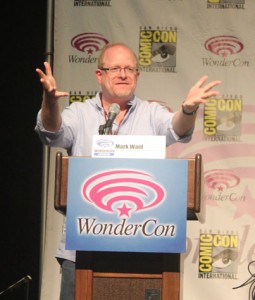 J. M. De Matteis introduced an image that stayed with the panellists as a reference point for discussion. He felt that creators handling long-lived characters work “within a cage”, so they can’t “go wide” with the character in term of change, but they can “go deep” in terms of making new discoveries. For De Matteis, personally, it’s all about the “Big Why” of characters, figuring out what makes them tick. He prefers working with super-villains to pose questions about the formative impact of their past histories because there’s “always a little corner of the psyche to dig into”. Ann Nocenti, however, in her recent work with Catwoman found that “her archetype was pretty clear” as a troubled kid originally, “on the streets” originally, and moving through “foster homes”. Her intuitive approach is to “play with a character and see what feels right” and she doesn’t mind the fact that later creators will do the same with long-term characters. It’s “like treading water”, she said, “You give a sense of constant, dynamic action, but you’re really not moving far”, and she expects later creators to be under the same constraint.
J. M. De Matteis introduced an image that stayed with the panellists as a reference point for discussion. He felt that creators handling long-lived characters work “within a cage”, so they can’t “go wide” with the character in term of change, but they can “go deep” in terms of making new discoveries. For De Matteis, personally, it’s all about the “Big Why” of characters, figuring out what makes them tick. He prefers working with super-villains to pose questions about the formative impact of their past histories because there’s “always a little corner of the psyche to dig into”. Ann Nocenti, however, in her recent work with Catwoman found that “her archetype was pretty clear” as a troubled kid originally, “on the streets” originally, and moving through “foster homes”. Her intuitive approach is to “play with a character and see what feels right” and she doesn’t mind the fact that later creators will do the same with long-term characters. It’s “like treading water”, she said, “You give a sense of constant, dynamic action, but you’re really not moving far”, and she expects later creators to be under the same constraint.
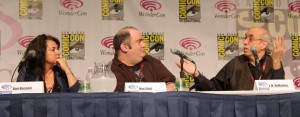 Doug Mahnke’s challenges, as an artist working on long-term heroes, is rather specific, handling costumes and their overtones. He observed that heroes, even today, often don’t look “contemporary” because their appearance has become iconic and we no longer question the anachronism, like Superman’s “underwear outside his pants”. Other features like capes and boots, Mahnke said, “made sense at the time” they were created based on a “swashbuckling” influence. In fact, he explained, an artist’s job is to “bring out the majesty in the character. It doesn’t matter so much what they’re wearing”, but you can use costume as a “tool” to use to your advantage.
Doug Mahnke’s challenges, as an artist working on long-term heroes, is rather specific, handling costumes and their overtones. He observed that heroes, even today, often don’t look “contemporary” because their appearance has become iconic and we no longer question the anachronism, like Superman’s “underwear outside his pants”. Other features like capes and boots, Mahnke said, “made sense at the time” they were created based on a “swashbuckling” influence. In fact, he explained, an artist’s job is to “bring out the majesty in the character. It doesn’t matter so much what they’re wearing”, but you can use costume as a “tool” to use to your advantage.
 Several of the panellists then commented on the fact that objectively, some of the nomenclature and costumes of characters created decades ago would seem “stupid” now. Nocenti’s example was a resurrection of a minor character, Zebra Man who was “visually fantastic” but the name and concept bizarre. Slott felt that once an icon is an icon, “the fact that it’s an icon gives it weight”, preventing further critique from readers. Even Waid’s considered opinion was that “Green Lantern” is a “stupid name for a character, but after 75 years”, it has “gravitas”.
Several of the panellists then commented on the fact that objectively, some of the nomenclature and costumes of characters created decades ago would seem “stupid” now. Nocenti’s example was a resurrection of a minor character, Zebra Man who was “visually fantastic” but the name and concept bizarre. Slott felt that once an icon is an icon, “the fact that it’s an icon gives it weight”, preventing further critique from readers. Even Waid’s considered opinion was that “Green Lantern” is a “stupid name for a character, but after 75 years”, it has “gravitas”.
 The panel then tackled the question of when and how exactly a character becomes officially iconic, and they set the bar high on awarding this status. De Matteis opined that “nothing about the character idea makes it iconic. It’s the execution”, and not every character reaches this status despite reasonably strong storytelling behind them. Dan Slott interjected that it only takes “one writer and one artist to do it”, like Frank Miller on DAREDEVIL. The discussion often drifted into slap-stick commentary on the more absurd aspects of superhero lore like the possession of a super vehicle as an icon accoutrement. Nocenti provided the little known detail that Cat Woman’s car is known as a “Catillac”. Slott confessed to proposing in a “meeting with real adults” that Superman’s car should be known as “Superman’s Ford Taurus of Solitude” with disasterous results.
The panel then tackled the question of when and how exactly a character becomes officially iconic, and they set the bar high on awarding this status. De Matteis opined that “nothing about the character idea makes it iconic. It’s the execution”, and not every character reaches this status despite reasonably strong storytelling behind them. Dan Slott interjected that it only takes “one writer and one artist to do it”, like Frank Miller on DAREDEVIL. The discussion often drifted into slap-stick commentary on the more absurd aspects of superhero lore like the possession of a super vehicle as an icon accoutrement. Nocenti provided the little known detail that Cat Woman’s car is known as a “Catillac”. Slott confessed to proposing in a “meeting with real adults” that Superman’s car should be known as “Superman’s Ford Taurus of Solitude” with disasterous results.
Waid observed that some characters are iconic in pop culture without necessarily being long-lived, like Woody Woodpecker, who’s highly recognizable, but not a currently active character. Waid commented that the tendency toward merchandizing may encourage the slow-down or freeze of new developments in a character since “every character becomes a beach towel” in the end. The entire panel segued into a long and fairly serious discussion of Wonder Woman as a character and why she has, or has not, lived up to her iconic status in terms of actual comic storytelling.

Most felt, like De Matteis, that Wonder Woman comics have not always been “all that good”, nevertheless the character definitely qualifies as “iconic”. Waid had a fairly idiosyncratic theory behind why this is the case. He observed that there was a strong “sexual element” to the “first 10 years of the strip” that was later removed to render the character more “plain vanilla”, and that now, lacking that “x-factor of sexuality”, stories fail to live up to the early days (an issue, he said, he frequently discusses with Grant Morrison). Slott disagreed pointedly with Waid’s assessment. He instead blames the lack of verve in Wonder Woman comics to the fact that comics are essentially a “make dominated industry” that has not explored the “many angles of the character” sufficiently. Slott still feels that if the right team is put together, the stories can rise to iconic status again, without recourse to the “weird quirky bits”. His choice of phrase caused plenty of giggling among the panellists.
This led Waid to ask his panel how they decide what elements are most essential to a character, what continues to translate, and what can be left behind. De Matteis advised to “always approach the characters psychologically and emotionally” and not worry too much about the “other stuff”, and sometimes that psychological appeal can be found in lesser known characters. Nocenti commented that her current work on KATANA based on the strange but intriguing concept of a “girl with a sword” produced “good potential” for developing “obsessional love triangle” elements between herself, her murdered husband, and his murdering brother.“The less iconic a character, the more fun you can have!”, she enthused.
Slott agreed with Nocenti on this idea, up to a point. When you’re handling an iconic character, readers lose the fear that their reckless lifestyles will do them in, whereas if a character is “unknown”, “Everyone is worried”, wondering if they will survive from issue to issue. Slott and Nocenti shared an interesting moment of commiseration, albeit brief, about their mutual killing off of Spider-based characters, and the emotional reaction of fans. “Screw letters from emotional fans”, Slott concluded, laughing, but Waid intervened by informing the audience that he’s sure Slott “weeps himself to sleep at night with 6 year olds’ fan mail” over the death of Spider-Man .
 The panellists didn’t always find their subject matter easy to decipher, nor did they feel that there’s always an easy answer for why some characters “click” as icons and some don’t. Batman, particularly, has a mysteriously successful dynamic, they said. But some things do change. Waid observed that he “couldn’t have imagined a world where I walked down the street and everyone knew who Tony Stark was” until after the Iron Man films had been made. Waid suggested that iconic status for characters might be measured in the number of imitators who have sprung up. De Matteis returned to his general position that archetypal patterns determine iconic status, however. Slott provided examples, stating that Superman is like Hercules, Batman a being on a vengeance-quest, and Tony Stark is, too, iconic in formula, as a combination of “Man and Machine”, an icon that the world is ripe for right now.
The panellists didn’t always find their subject matter easy to decipher, nor did they feel that there’s always an easy answer for why some characters “click” as icons and some don’t. Batman, particularly, has a mysteriously successful dynamic, they said. But some things do change. Waid observed that he “couldn’t have imagined a world where I walked down the street and everyone knew who Tony Stark was” until after the Iron Man films had been made. Waid suggested that iconic status for characters might be measured in the number of imitators who have sprung up. De Matteis returned to his general position that archetypal patterns determine iconic status, however. Slott provided examples, stating that Superman is like Hercules, Batman a being on a vengeance-quest, and Tony Stark is, too, iconic in formula, as a combination of “Man and Machine”, an icon that the world is ripe for right now.
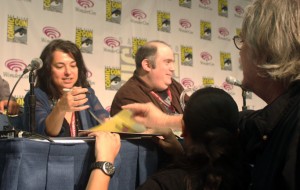 The panellists’ parting thoughts during the Q and A period focused on an interesting point made from the audience about the superhero/villain ratio. With so many more supervillains than superheroes in comics, “recycling” them is the norm, but at what point do they become “stale” and need to be retired, at least for awhile? De Matteis was firm about the roles of the artist and writers, insisting that there are “no stale characters but stale interpretations of characters” and that good work will prevent this problem. “Every character is great if you did into them in the right way”, he said. Waid’s closing example to support De Matteis’ point was that “20-25 years ago, no one would have thought that GREEN ARROW would become 2 times the best selling DC book, and then get his own TV show”. His bottom line: “If you dig deep enough you can find something that resonates”, and that’s the key to creating an icon, something that may not happen overnight.
The panellists’ parting thoughts during the Q and A period focused on an interesting point made from the audience about the superhero/villain ratio. With so many more supervillains than superheroes in comics, “recycling” them is the norm, but at what point do they become “stale” and need to be retired, at least for awhile? De Matteis was firm about the roles of the artist and writers, insisting that there are “no stale characters but stale interpretations of characters” and that good work will prevent this problem. “Every character is great if you did into them in the right way”, he said. Waid’s closing example to support De Matteis’ point was that “20-25 years ago, no one would have thought that GREEN ARROW would become 2 times the best selling DC book, and then get his own TV show”. His bottom line: “If you dig deep enough you can find something that resonates”, and that’s the key to creating an icon, something that may not happen overnight.
Photo Credits: All photos in this article were taken by semi-professional photographer and pop culture scholar Michele Brittany. She’s an avid photographer of pop culture events. You can learn more about her photography and pop culture scholarship here.
Hannah Means-Shannon writes and blogs about comics for TRIP CITY and Sequart.org and is currently working on books about Neil Gaiman and Alan Moore for Sequart. She is @hannahmenzies on Twitter and hannahmenziesblog on WordPress.

By:
Heidi MacDonald,
on 3/26/2013
Blog:
PW -The Beat
(
Login to Add to MyJacketFlap)
JacketFlap tags:
Top News,
andy kubert,
Brad Walker,
Rags Morales,
Reviews,
Comics,
DC,
Superman,
Grant Morrison,
Action Comics,
Add a tag
Grant Morrison’s run on Action Comics has been met with both high praise and no small measure of bewilderment. But this is a legendary run – you just need to think five dimensionally.
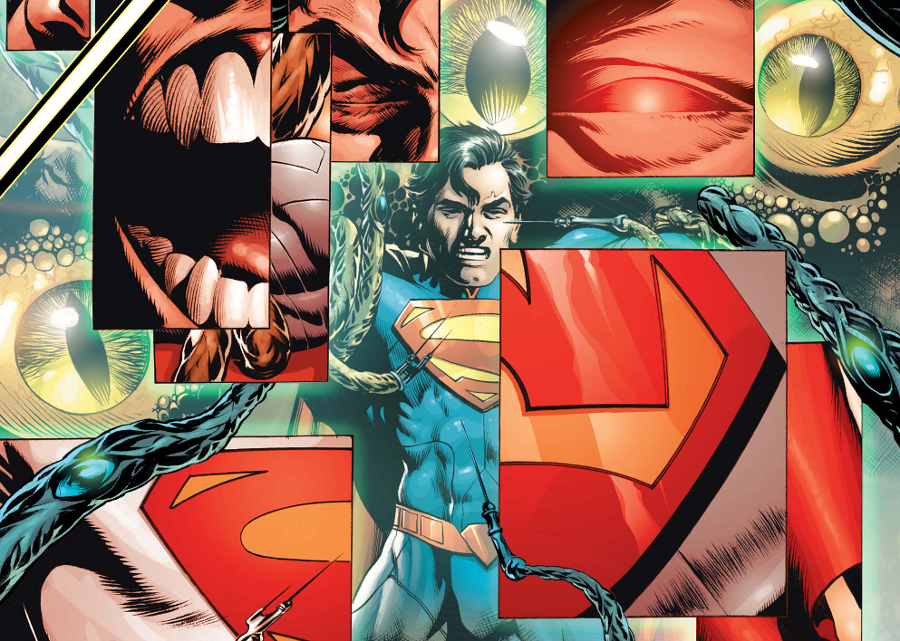
When Morrison was announced as the writer of Action Comics #1, back in 2011, there was a great deal of excitement within the comics community. The man who had given us one of the greatest Superman books of all time, All-Star Superman, seemed a poetic choice as the architect of this brand new history. Morrison spoke of his love for the original Golden Age character, his socialist roots and desire to do good in the world; Superman as a folk tale, before he became the centrepiece of our modern mythology. The young Kal, standing proud and over-confident in his American jeans and self-branded t-shirt, cape flying behind him as he raced from one adventure to the next.
Action Comics, set five years behind the current day Superman comic, was to show us how Kal went from farmboy to international hero – from brash young man to a wiser one – but also to introduce all the pieces of the puzzle that make him who he is. There was fan outcry at the pre-publication revelations that Clark and Lois would no longer be a couple, and that Clark’s parents would no longer be alive. Comic fans, strangely adverse to change in a constantly recycling continuity, were outraged at the lack of a romantic plot with Lois, perhaps inadvertently recasting her in their minds as in existence only to please the leading man. The lack of parents of course linked this Superman much more strongly to his Golden Age roots, and removed him too from any existing connections to the world he found himself living on. An alien alone.
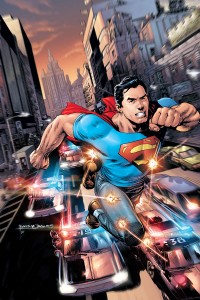 As Morrison’s run kicked off, with newspapers still fascinated by the jean-clad Superman and somehow missing the alarm bells that usually come with any mention of “socialism”, it soon became clear that Morrison’s ambitions were far greater than previously stated. This was not to be merely the introduction of the character, but the making of him – joining up pieces of a fragmented puzzle to show the whole, a Superman for a new generation of readers that brought the best of every previous incarnation along for the ride. Perhaps not surprising given the writers similar treatment of Batman, but the sheer scale of this particular endeavour given the extremely tight timescale is rather phenomenal.
As Morrison’s run kicked off, with newspapers still fascinated by the jean-clad Superman and somehow missing the alarm bells that usually come with any mention of “socialism”, it soon became clear that Morrison’s ambitions were far greater than previously stated. This was not to be merely the introduction of the character, but the making of him – joining up pieces of a fragmented puzzle to show the whole, a Superman for a new generation of readers that brought the best of every previous incarnation along for the ride. Perhaps not surprising given the writers similar treatment of Batman, but the sheer scale of this particular endeavour given the extremely tight timescale is rather phenomenal.
Unsurprisingly, many readers were somewhat lost at various points – because when I say fragmented, I am being quite literal. After only four issues it was necessary for artist Rags Morales to need a break to catch up, and another plot was inserted with both the baby Kal’s escape from Krypton, and a future Superman returning to a point in time not long after the previous issue. The change in art style thanks to Andy Kubert for this two issue interlude helped underscore the time difference, and in issue seven we were back on our original track. These interludes became a signature of Morrison’s run, with further adventures spending time on the Superman of Earth 23 – and a meta teaser for Morrison’s upcoming Multiversity – as well as a Halloween trip to the Phantom Zone, and of course the obligatory issue zero with its genuinely heartwarming tale.
But here’s the thing: Morrison planned a short six issue run on the comic. When the first artist change came up, he told me that:
“…for me it hits the long term collections of it to have things done like that but at the same time it brings back a lot of the freshness and improvisation of doing comics again and just responding to that and also sometimes you know they’ll be like we need a two part filler here – okay I’ll just come up with something, and it might not necessarily fit it in to the middle of this but okay, you need a filler.”
And yet, every little aspect of this comic – from the future plot to the Phantom Zone to the appearance of the little teetotal man in the first panel of issue one – suggests a much grander plan. If I was uncharitable I’d chalk this up to a mild case of fibbing, but I know that’s not the case. Of course it’s likely that someone with so much knowledge of the DC universe would subconsciously drop little things in to the narrative that might turn out to be useful later – but for a six issue run? It’s a marvellous little contradiction that is completely in keeping with the unfolding story itself, perhaps demanding that it be told.
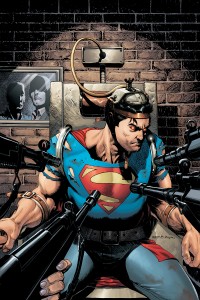 So we have the initial plot, the tale of Clark finding his feet as an investigative journalist and being a superhero in a world without superheroes – for he was the first – while the world reacts with suspicion, just in time for the Collectors to appear on the scene labelling Earth as a doomed planet. Clark is also receiving communications from a secretive person named Icarus, while Lex Luthor attempts to negotiate for his own life with the incoming alien threat. Superman of course saves the day, after pushing himself further than ever before, and the people of Earth are happy to have their own personal saviour. Kal even gets a shiny new suit out of it.
So we have the initial plot, the tale of Clark finding his feet as an investigative journalist and being a superhero in a world without superheroes – for he was the first – while the world reacts with suspicion, just in time for the Collectors to appear on the scene labelling Earth as a doomed planet. Clark is also receiving communications from a secretive person named Icarus, while Lex Luthor attempts to negotiate for his own life with the incoming alien threat. Superman of course saves the day, after pushing himself further than ever before, and the people of Earth are happy to have their own personal saviour. Kal even gets a shiny new suit out of it.
This alone woud be a solid little arc, establishing Kal as an accepted hero, uniting him with Brainiac and his Fortress of Solitude, placing Lex, Lois and Jimmy on our radar of people to look out for, and… well, also hinting at the involvement of the 5th dimension, casually mentioning a missed visit that is later revealed to be the Legion of Superheroes, foreshadowing the appearance (and constant invisible presence) of Krypto, a suggestion that the small man is the devil, and the introduction of Nimrod who we know will shoot Superman in the brain in the future because we’ve seen it in a past issue, as well as the K-Men who don’t actually quite exist yet because they’re from the future also, and the future form of Eric Drekken and the existence of the “First Superman”.

All in all, it’s a good job Morrison stayed on to write more as while those plot bunnies would have given any writer much to play with, it’s clear that by now there was a greater plan in mind. In the first 8 issues, the fragments were already starting to tug apart, and I was reminded of Morrison’s fondness for telling stories that can only be told in comic form. In comics, unlike say films or games, each story is already a four dimensional experience – the reader is in control of the pacing and movement through time, even able to reverse time or skip from one time to another. With comics, the one thing that sets them apart from all other media – for me – is the gap between the panels. What happens in the gutters is completely unique to each and every reader, from the simple movements of a character across time, to the shifts between place, person and stories. When a writer chooses to increase those gaps, not only between sequenced panels but between issues, between pages, and between stories being told simultaneously at different time points, the story becomes even more interactive. A co-creation between creators and readers alike.
 The fragments can be jarring, until you read further and more gaps are filled. This is partly due to the nature of the Big Bad, a 5th dimensional bastard named Vyndktvx, but it also serves to both explain the multitude of artists on the book, and to fill in those five years between issue one and where the character is supposed to end up. Five years over a handful of issues results in snapshots in time, little episodes that are important in the forming of Superman himself rather than an exhaustive chronological list. Superman was hated and feared – but not for long. Superman gave up his Clark Kent identity – but not for long. Superman is exasperated by the perceived inactivity of the other superheroes – but not for long. Superman plays can and mouse with Lex Luthor – but not for long. Superman interacts with Lois and Jimmy – but not for long. And so on. We know who Superman becomes, we have seen that story before in a million different varieties. But for this Superman, what is important? The chance to say goodbye to his father. The return of his faithful hound who never left his side. The children who found shelter in his cape. His landlady who gave everything to help him survive. That Kents never give up and that no matter what, he’ll never really be alone.
The fragments can be jarring, until you read further and more gaps are filled. This is partly due to the nature of the Big Bad, a 5th dimensional bastard named Vyndktvx, but it also serves to both explain the multitude of artists on the book, and to fill in those five years between issue one and where the character is supposed to end up. Five years over a handful of issues results in snapshots in time, little episodes that are important in the forming of Superman himself rather than an exhaustive chronological list. Superman was hated and feared – but not for long. Superman gave up his Clark Kent identity – but not for long. Superman is exasperated by the perceived inactivity of the other superheroes – but not for long. Superman plays can and mouse with Lex Luthor – but not for long. Superman interacts with Lois and Jimmy – but not for long. And so on. We know who Superman becomes, we have seen that story before in a million different varieties. But for this Superman, what is important? The chance to say goodbye to his father. The return of his faithful hound who never left his side. The children who found shelter in his cape. His landlady who gave everything to help him survive. That Kents never give up and that no matter what, he’ll never really be alone.
 This is not the Superman of All-Star Superman. That Superman was older, matured, and a perfect focus of the Silver Age made real. This Superman is born from the pages of the Golden Age, each issue showing another edge of the same character while introducing the instruments of his incredibly complex life. He’s just a man who will never give up – the message at both the beginning of issue one as he threatens a corrupt businessman, to the end of issue eighteen where he hugs his dog and jokes about his hard won fight for both his life and the entire universe. An alien alone perhaps, but one who is very human. All-Star Superman was a god you could believe in; Action Comics Superman gets shit done.
This is not the Superman of All-Star Superman. That Superman was older, matured, and a perfect focus of the Silver Age made real. This Superman is born from the pages of the Golden Age, each issue showing another edge of the same character while introducing the instruments of his incredibly complex life. He’s just a man who will never give up – the message at both the beginning of issue one as he threatens a corrupt businessman, to the end of issue eighteen where he hugs his dog and jokes about his hard won fight for both his life and the entire universe. An alien alone perhaps, but one who is very human. All-Star Superman was a god you could believe in; Action Comics Superman gets shit done.
 Having Superman face off against the devil, a jealous little man from another dimension who poses as dealer, bartender and lawyer, is a neat touch. Vyndktvx is not only attacking Kal at the end of the run but has been attacking him all his life, sometimes in ways that Kal will never know and perhaps never should. He is even the figure responsible for the Super-Doomsday, an “unstoppable killer franchise from a parallel reality” that is perhaps a shade too close to our own little Earth. Commentary on Superman as corporate symbol would appear to be in conflict with Morrison’s previous comments on Superman’s heritage, but not when you look between the lines. Vyndktvx’s pledge to “make coins of” Superman, and his subsequent failure is a clear illustration that Superman the mythic symbol of our age lives beyond corporate lines and greed. His past may be murky, but Superman’s ability to inspire is unstoppable. At least, in the hands of Morrison.
Having Superman face off against the devil, a jealous little man from another dimension who poses as dealer, bartender and lawyer, is a neat touch. Vyndktvx is not only attacking Kal at the end of the run but has been attacking him all his life, sometimes in ways that Kal will never know and perhaps never should. He is even the figure responsible for the Super-Doomsday, an “unstoppable killer franchise from a parallel reality” that is perhaps a shade too close to our own little Earth. Commentary on Superman as corporate symbol would appear to be in conflict with Morrison’s previous comments on Superman’s heritage, but not when you look between the lines. Vyndktvx’s pledge to “make coins of” Superman, and his subsequent failure is a clear illustration that Superman the mythic symbol of our age lives beyond corporate lines and greed. His past may be murky, but Superman’s ability to inspire is unstoppable. At least, in the hands of Morrison.
The revelation that the universe was born from Mxyzptlk’s hat, and subsequently that many worlds were destroyed by the multitude, the three dimensional interpretation of the multispear, is an interesting play on gods toying with their creations from above – and of course a parallel of the ability of creators to manipulate their own paper universes. That Kal is a favourite of his 5th dimensional audience for his ability to not be controlled – alongside his father – places him at the centre of the story for reasons beyond him simply being Superman. His angering of a petty god leads to his life being irrevocably damaged, neatly fitting in with the New 52 changes and perhaps hinting at a deeper message.
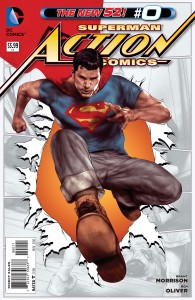 This is an ambitious run, all the more so for how everything does in fact tie together in the end. Even the smallest throwaway comments in the early issues are given meaning in later reveals, while the back up strips by Sholly Fisch (and the Action Comics Annual #1) are uncannily in tune with the main comic as well as giving deeper insights into Kal’s humanity. As time and story starts to slide sideways, with Vyndktvx breaking the fourth wall, the creators themselves appearing alongside the hand of god, and angels tumbling from the sky, the time slips start to collide with the whole picture becoming clear. With the arrival of the final issue I spent a few hours reading the entire run first, and the effect is rather like standing back from a tapestry to see all the threads intertwine.
This is an ambitious run, all the more so for how everything does in fact tie together in the end. Even the smallest throwaway comments in the early issues are given meaning in later reveals, while the back up strips by Sholly Fisch (and the Action Comics Annual #1) are uncannily in tune with the main comic as well as giving deeper insights into Kal’s humanity. As time and story starts to slide sideways, with Vyndktvx breaking the fourth wall, the creators themselves appearing alongside the hand of god, and angels tumbling from the sky, the time slips start to collide with the whole picture becoming clear. With the arrival of the final issue I spent a few hours reading the entire run first, and the effect is rather like standing back from a tapestry to see all the threads intertwine.
Honestly, I could spend thousands of words picking out all the links and meta-touches here, and still it would do no good – because what you, dear reader, insert in between those gaps and how you read the comic, through the manipulation of time and touch, and what you decide it all comes to… well that’s what makes the comic.
But I defy anyone not to have a little sniffle at the return of Krypto, and for the boys who borrowed Superman’s cape.

Ha-la Kal-El, ha-la-la!
Action Comics #1-18
Writer: Grant Morrison
Pencillers: Rags Morales, Brad Walker, Andy Kubert, Gene Ha, Travel Foreman, Cafu
Inkers: Andrew Hennessy, Mark Propst
Colourist: Brad Anderson, Art Lyon
Cover Artist: Rags Morales, Brad Anderson
Letters: Steve Wands, Patrick Brosseau
Editor: Matt Idelson, Will Moss
Publisher: DC
[Laura Sneddon is a comics journalist and academic, writing for the mainstream UK press with a particular focus on women and feminism in comics. Currently working on a PhD, do not offend her chair leg of truth. Her writing is indexed at comicbookgrrrl.com and procrastinated upon via @thalestral on Twitter]

I saw the final night of the ENCORE! concert staging of ythe Adams/Strouse Superman musical last night and I truly wish I had seen it earlier so I could have written about it earlier and told everyone to go see it because it was a DELIGHT! but the theater was jammed so I guess it didn’t need my rave! (I spotted Joss Whedon among those taking it in!)
Everything about this production was charming and fizzy and fun, starting with the bold splashy sets filled with pop art ben day dots and explosions. Originally produced in 1966, this was very much a period piece, but people were a lot more sophisticated in 1966 then we give them credit for, from Lois’s kicky mod dresses to the sly suggestion that Superman is a little more into his celebrity than his heroism might indicate.
The cast was note perfect, from Edward Watts strapping, slightly goofy but always sincere Superman; Jenny Powers as a pert, yearning Lois, David Pittu and Will Swenson bringing down the house as a pair of villains.
This musical came out a few months after the campy Batman TV show debuted, a reminded that the DC superheroes were already a significant part of the cultural consciousness. It’s a Bird’s Superman plays on the same kind of cartoonish approach to the idea of the Superhero — both Batman and Superman are just “good guys” who solves petty street crimes and vanquish the occasional wackadoo with an unlikely hairdo—but it’s a lot more amenable to the idea that we need an amazing hero to look up to, even if he is a little bit slow on the uptake about a few things, like romance and mad scientists with evil schemes.
All the singing and dancing and acrobatics was outstanding, and I left the theater humming the tunes…something I could not say about SPIDER-MAN: TURN OFF THE DARK. Different stories for different times.
Anyway, great fun, and I’m really glad I got to see it.
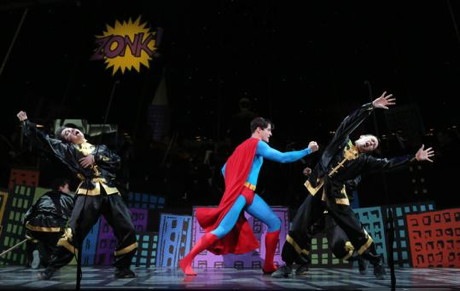



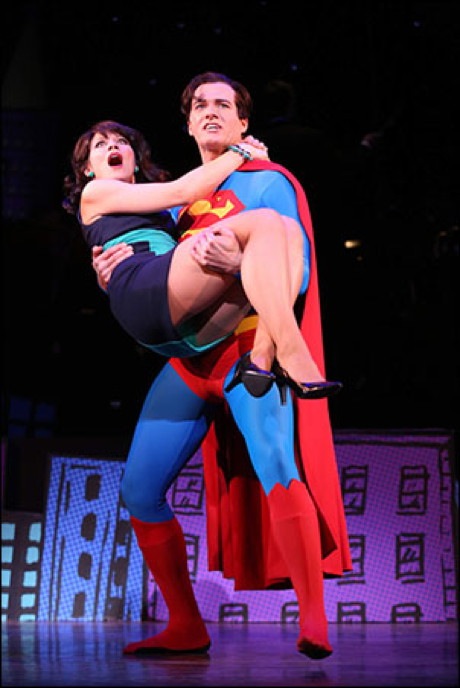


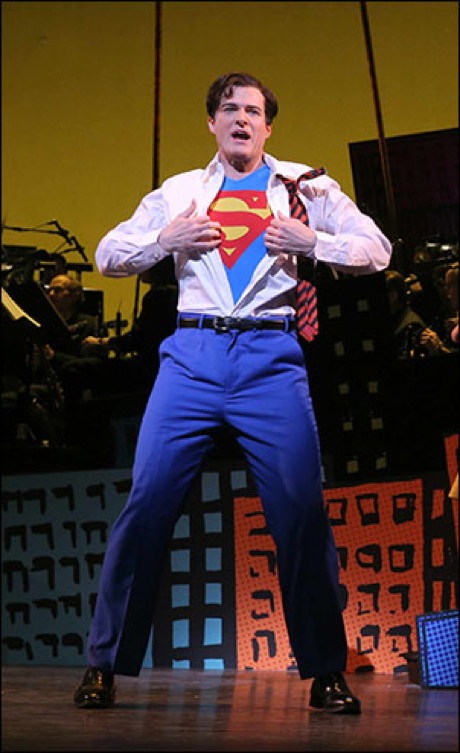
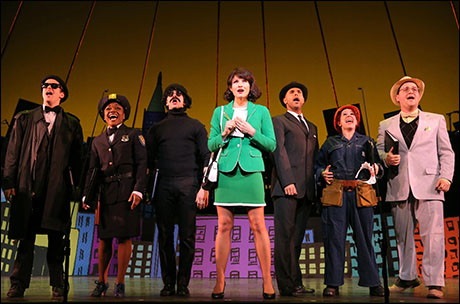
In All-Star Superman #1, writer Grant Morrison retold the origin of Superman in only eight artfully chosen words:
On Twitter, Dave Lartigue (@daveexmachina) retold the origin of Batman in only eight artfully chosen words:

By:
Heidi MacDonald,
on 3/8/2013
Blog:
PW -The Beat
(
Login to Add to MyJacketFlap)
JacketFlap tags:
Events,
Comics,
DC,
Superman,
Al Jaffee,
Jerry Robinson,
Columbia University,
Karen Green,
Paul Levitz,
Top News,
Elfquest,
Larry Tye,
Denny O'Neill,
Jay Emmet,
Add a tag
On January 23rd, Columbia University Library acquired a double-bill of Golden Age related comics materials, including the research materials Larry Tye compiled to write his Superman biography, The High Flying History of America’s Most Enduring Hero, and six 1940’s BATMAN scripts from the estate of Jerry Robinson. These add to the ongoing Rare Book and Manuscript Collection at Columbia under the steerage of Graphic Novels Librarian Karen Green, already including Chris Claremont’s 2011 X-Men archive donation, and the large ELFQUEST bequest announced in early March. Columbia University, and a standing room only audience on March 7th, decided it was time to celebrate the donation, with a panel and reception entitled “Comics at Columbia: The Golden Age”, fortuitously coinciding with Will Eisner Week throughout the country.
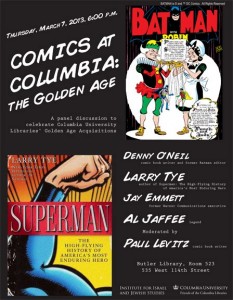
The panel was moderated by Paul Levitz, educator, writer, and former president of DC Comics, and included Jay Emmet, former Warner Communications executive responsible for some of the first licensing of DC characters into toys and games, Denny O’Neil, former BATMAN editor and comic book writer, Al Jaffee, whose ongoing career as an artist on MAD Magazine can only be described as legendary, and Larry Tye, journalist and biographer, most recently of Superman.
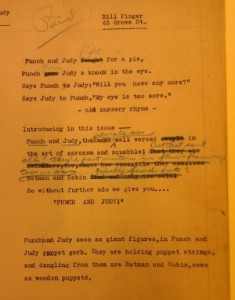
Levitz introduced panelists who he hoped would help express the Golden Age of comics as “lived and seen” and trace the impact of the Golden Age into later comics history and his synopses of their careers pointed out that Emmet’s licensing of toys and action figures changed American childhood experience, O’Neil’s career sparked an era of “social consciousness” in comics, Jafee’s work introduced the tradition of “wiseass” humor into American comics, and that Tye has brought a level of “serious” journalism and biography to comics history by carefully engaging with all those whose lives have impinged on Superman’s development.

Levit’z general question to his panelists, “Why comics?” sparked a great deal of discussion as each member delved into their own pasts and tried to convey how they became drawn into comics as a career and what part comics have played in their lives. Jaffee supplied the historical context for comics just before World War II. At the “height of the depression”, he said, with “non-existent job prospects and anti-Semitism engulfing Europe”, he and many of his contemporaries found that the “old, established advertizing agencies” in New York would simply reject applications from those with Jewish names. Comics, on the other hand, Jaffee explained, were dominated by Jewish editors, artists, and writers, and beginning to flourish at that time. Since “comic book people were receptive”, Jaffee said, he and his contemporaries “jumped into it”, particularly since it was a paying gig.

Emmet was born into the comics industry, as the nephew of a Warner board member, and he spoke quite frankly about the “greed” and money-driven aspects of the industry that he perceived growing up. He reflected on his own role in getting lifetime sum of money for Siegel and Schuster, but from a merchandiser’s perspective, Emmet still felt that the lack of pay for the creators of Superman was negligible. Emmet’s most personal story, however, included a “sad story”, as Jaffee described it, of having an entire “silo” of comic books and pop culture memorabilia destroyed by his spring-cleaning wife who didn’t realize their emotional value to him. Needless to say, as the nephew of a Warner executive, Emmet had “every issue” of Golden Age comics in the destroyed collection.
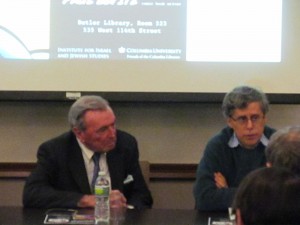
O’Neil spoke about his work post Golden Age, handling many of the same characters. Levitz asked O’Neil why he felt characters like Superman and Batman have lasted so long, and are still relevant today. O’Neil’s eloquent response conveyed a great deal about his philosophy of comics creation. You have to “keep the essence of characters intact but let them evolve”, he explained, a lesson he learned from Julie Schwartz. It’s essential, O’Neil feels, to “let the character reflect what’s outside the window” to remain relevant, and it’s “those allowed to evolve who are still with us”, he concluded.
Levitz humorously pointed out that of the panelists, most “wandered into comics before frontal lobes were fully developed for judgment”, leaving them little choice but to pursue the medium, however, Tye’s position as a biographer returning to comics as subject matter was unique. Tye explained that the question of why Americans embrace the heroes that they do led him to write his biography of the Man of Steel. He, too, however, had a childhood connection to Superman, and loved working on the book for two years, feeling “10 years old” again.
Levitz asked individual panelists some specific questions about their areas of expertise, and started off by asking Emmet to explain just how DC licensing came about. Emmet explained that licensing was a new idea when he was a young publicist, and that he wanted to do “what hadn’t been done before”. Remarkably, his uncle tried to dissuade him from giving up a cushy job to pursue licensing, but Emmet proved predictions wrong by making astonishing sales in his first year of work by simply visiting and personally pitching DC character licensing to every toy company in New York. When Jaffee was asked to talk about daily life working for MAD as a young man, as many cartoonists today will find relatable, he said he simply spent all his time cartooning. Jaffee discussed one unique aspect of working for MAD that stood in contrast to working on superhero comics, that he could “use many characters” and had “freedom” since MAD was a “voracious consumer of material”, but that the pressure could be intense to come up with new ideas since “I was only as good as the next idea I had”.
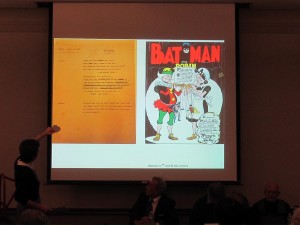
O’Neill was asked to discuss how he managed to write over a 1000 BATMAN stories and still keep material fresh for readers. He admitted that he personally has a “low attention span” and is “bored easily” so tried to bring that reality to his work. He “set the rules” for himself early on with a 5 page document that spread to 35 pages of notes by the end of his career reminding him of guidelines to keep Batman’s universe on track. But after that, as an editor, the key was to hire “good creative people” and give them a “sense that what they are doing is not trash”, and then know, as an editor, when to “step back”. Imbuing creators with a sense that their work has some particular value to readers and fans formed one of the themes for the evening’s discussion. O’Neil memorably commented that while writing comics for him was a “job” and he was cognizant of the need to provide for his family, the “first death” of Robin, decided upon by reader-response phone-calls to “vote” on whether Robin would “survive”, was a wake up call for him about the significance of his work. Ordering food in a deli one day soon after Robin’s “death”, the owner heard he edited BATMAN and declared to the other customers that this was the guy who had “killed Robin”. Previous to that moment, O’Neil said, he had felt he was working in a “backwater” of publishing, but afterwards felt that he was, in fact, a “custodian of post industrial folklore” with deep meaning for readers. It was a sobering moment for him that conveyed a sense of “uncomfortable responsibility” and “enormous privilege”.

Tye, certainly, agreed with the value of comics as an art form and the essential role of preserving and archiving documents, explaining that two kinds of records are particularly important in preserving comics history, the written documents, such as those produced in the Siegel and Schuster law cases that shed light on the Golden Age of comics, and secondly, the documentation of oral histories from those involved in the early days of comics who are still living. All the panelists agreed that they hope soon Columbia Library will also be able to archive audio recordings of oral histories, and many of the scholars and professionals attending the event in the audience confirmed that they have recordings that might be useful for such an archive. In the age of digital files and increasingly easy transfer between older formats and digital files, why not? Karen Green agreed that it was a possibility for Columbia to attempt to preserve these files in the future as part of their comics-related collection.
Levitz’ final assessments about the contribution of his panelists to pop culture included Emmet’s role in “creating American childhood” through licensing, Jaffee’s pioneering persona in encouraging us to “question everything” through his work on MAD, and the social realities that O’Neil introduced and maintained in comics, as well as Tye’s invaluable contribution to uncovering the history of Superman as a cultural phenomenon. It was certainly an evening spent celebrating comics, and in particular, a time to look back on the seminal periods in the development of comics that were directed in their development by true pioneers. What better way to dignify the impact of comics than to preserve their original documents for future study and appreciation? Collecting and archiving comics materials at Columbia has quickly moved from a new program to a steady stream of worthy additions, and the panel celebration suggested increasing momentum in preserving comics history at Columbia.
Hannah Means-Shannon writes and blogs about comics for TRIP CITY and Sequart.org and is currently working on books about Neil Gaiman and Alan Moore for Sequart. She is @hannahmenzies on Twitter and hannahmenziesblog on WordPress.
Artist Chris Sprouse, who would have been drawing controversial writer Orson Scott Card’s contribution to the upcoming Superman anthology Adventures of Superman, has stepped down from the project today. He cites the media furore over the comic as his reason for dropping the project. As a result, the first issue of this digital-first series will feature stories from Jeff Parker/Chris Samnee, Justin Jordan/Riley Rossmo, and Jeff Lemire.
DC have also issued a statement hoping to see Sprouse on a new project soon. Hopefully this will be a Superman one as well, because his Superman is super-aces –
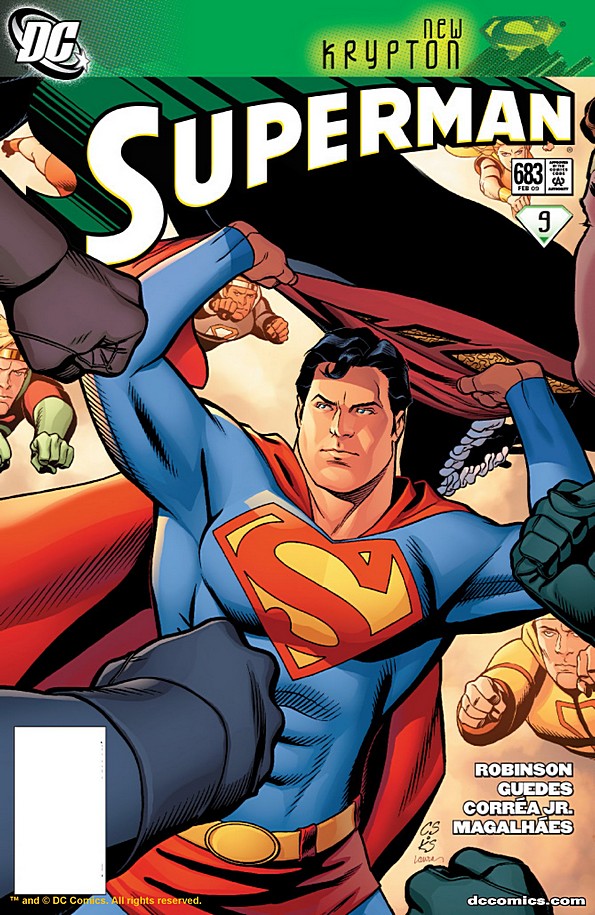
Sprouse’s statement regarding leaving the comic, which became controversial due to Card’s well-known association with anti-gay activism, is as follows:
The media surrounding this story reached the point where it took away from the actual work, and that’s something I wasn’t comfortable with. My relationship with DC Comics remains as strong as ever and I look forward to my next project with them.
DC have responded amicably to the artist’s decision, saying:
We fully support, understand and respect Chris’s decision to step back from his Adventures of Superman assignment. Chris is a hugely talented artist, and we’re excited to work with him on his next DC Comics project. In the meantime, we will re-solicit the story at a later date when a new artist is hired.
The issue was scheduled for April, and had sparked a massive debate over whether Card was the wisest of choices for DC to hire on a Superman story. Some people thought he should have the right to free speech, some people thought maybe DC shouldn’t have hired a real world villain to write a Superman story. That oil-and-water combination of opinions has basically been interminably floating over comic book comment threads, and everybody’s had a really good, friendly time of things.
The real news from all this? It’s that there’s no need for people to boycott issue #1 anymore! Jeff Parker! Chris Samnee! Superman! Wooooooo!!

By:
Heidi MacDonald,
on 2/20/2013
Blog:
PW -The Beat
(
Login to Add to MyJacketFlap)
JacketFlap tags:
Superman,
90s Comics,
Top News,
Dan Jurgens,
Death of Superman,
Jerry Ordway,
Louise Simonson,
Roger Stern,
Reviews,
Graphic Novels,
Comics,
DC,
Add a tag
TweetNowadays we think of it as the pre-mullet era of Superman, but at the time The Death of Superman was an incredibly big idea for DC. A story which killed off their main signature hero was not only an eventual inevitability, but also an idea which would actually have some resonance for the company. Superman [...]
TweetThere’s been controvery over the past few days following DC’s decision to hire Orson Scott Card, a pioneer in contemporary homophobia, as one of the writers on a new digital-first Superman anthology series. And although the internet has been going back and forth on the subject for the past few days, the first active step [...]
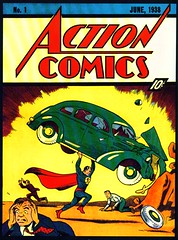 Superman, co-created by writer Jerry Siegel and artist Joe Shuster, first appeared in Action Comics #1 in June 1938, published by Detective Comics Inc, a fore-runner of National Periodical Publications and DC Comics. Virtually overnight it became a huge seller, and is running to this day, with uninterrupted publication for well over seventy years. A vast amount has been written over the years on the history of Superman, and by people substantially more qualified than I, but one claim, that Superman was based on the character of Hugo Danner, from Philip Wylie’s novel Gladiator, (Alfred A. Knopf, New York, 1930), has some relevance to the larger story of Marvelman and, although I decided that it might be too far back to start this series of articles, if you’re interested in reading what I have to say about it, you should go read this article, and then meet us back here.
Superman, co-created by writer Jerry Siegel and artist Joe Shuster, first appeared in Action Comics #1 in June 1938, published by Detective Comics Inc, a fore-runner of National Periodical Publications and DC Comics. Virtually overnight it became a huge seller, and is running to this day, with uninterrupted publication for well over seventy years. A vast amount has been written over the years on the history of Superman, and by people substantially more qualified than I, but one claim, that Superman was based on the character of Hugo Danner, from Philip Wylie’s novel Gladiator, (Alfred A. Knopf, New York, 1930), has some relevance to the larger story of Marvelman and, although I decided that it might be too far back to start this series of articles, if you’re interested in reading what I have to say about it, you should go read this article, and then meet us back here.
Tweet Yesterday’s summary judgment filings confirm that settlement talks have been ongoing–and the Siegel side is in disarray.The motion filed yesterday was as expected as a player trotting to first base after ball 4. When an appeals court sends a case back down saying that the case is all but over but the filing, the [...]
One of the most colorful ephemera of Superman lore is his stage appearance in the show "It's a Bird...It's a Plane...It's Superman!" a musical with book by David Newman and Robert Benton, and music by Charles Strouse and lyrics by Lee Adam (That's the guys behind Bye Bye Bride and Applause.) The show is being revived for a seven performance run at New York City Center from March 20 through 24. Tickets can be purchased here.
Tweet News reports are circulating that the Siegel and Shuster heirs have asked the lower court to dismiss DC’s copyright lawsuits. What actually happened is rather different. The Siegel and Shuster heirs’ attorney, Marc Toberoff, appears to have conceded that the Superman copyright dispute is over and the heirs have lost. Here’s what happened in [...]
View Next 25 Posts





 " Saucy is a real character dealing with real stuff—hard stuff that doesn’t have easy answers, not in real life and not in fairy tales, either. This is a really compelling and ultimately hopeful story. Highly recommended."
– Debby Dahl Edwardson, National Book Award finalist and author of My Name is Not Easy
" Saucy is a real character dealing with real stuff—hard stuff that doesn’t have easy answers, not in real life and not in fairy tales, either. This is a really compelling and ultimately hopeful story. Highly recommended."
– Debby Dahl Edwardson, National Book Award finalist and author of My Name is Not Easy




































+-+cover.jpg)



























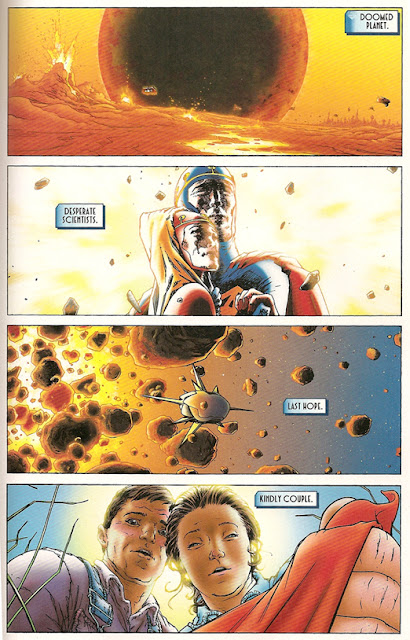









 Superman, co-created by writer Jerry Siegel and artist Joe Shuster, first appeared in Action Comics #1 in June 1938, published by Detective Comics Inc, a fore-runner of National Periodical Publications and DC Comics. Virtually overnight it became a huge seller, and is running to this day, with uninterrupted publication for well over seventy years. A vast amount has been written over the years on the history of Superman, and by people substantially more qualified than I, but one claim, that Superman was based on the character of Hugo Danner, from Philip Wylie’s novel Gladiator, (Alfred A. Knopf, New York, 1930), has some relevance to the larger story of Marvelman and, although I decided that it might be too far back to start this series of articles, if you’re interested in reading what I have to say about it, you should go read
Superman, co-created by writer Jerry Siegel and artist Joe Shuster, first appeared in Action Comics #1 in June 1938, published by Detective Comics Inc, a fore-runner of National Periodical Publications and DC Comics. Virtually overnight it became a huge seller, and is running to this day, with uninterrupted publication for well over seventy years. A vast amount has been written over the years on the history of Superman, and by people substantially more qualified than I, but one claim, that Superman was based on the character of Hugo Danner, from Philip Wylie’s novel Gladiator, (Alfred A. Knopf, New York, 1930), has some relevance to the larger story of Marvelman and, although I decided that it might be too far back to start this series of articles, if you’re interested in reading what I have to say about it, you should go read
John Romita Jr. is one of the best artist to be working in the busines in the past 20 years, and very likely the best storyteller. Should be interesing to see what he can do with Superman.
Never really understood the appeal of this man’s art.
How is it outside the new 52? Superman is in the Jim Lee Armor, and it’s written by Geoff Johns, one of the architects of the reboot.
Yeah – gotta go with what Zach says here. What does “outside of the new 52″ mean when it’s written by Geoff Johns and is clearly the Jim Lee redesign of the suit? And it’s in the regular Superman book – not a special one shot or whatever. It isn’t like this is an issue of the now cancelled Adventures of Superman title or something – this is the core continuity.
(Unless you’re saying that this isn’t like the New 52 Superman we’ve been stuck with for the last few years and they’re once again trying something “new” with the character. Which is, I think, what everyone was assuming they were going to be doing given that they’ve put Geoff Freaking Johns on the title.)
John Romita Jr.’s art is AMAZING. And then he met Klaus Janson, and decided Klaus was a great inker for him! And his art has never been as amazing, since… sigh.
John Romita Jr. is a class act. The good-humored advice and mentorship he gave me early in my career was invaluable, his work ethic is second to none and his charity work blows me away. PLUS HE IS A STORYTELLER, AND HE DRAWS HIS ASS OFF. Superman is lucky to have him.
Perhaps the “outside the new52″ thing was a poorly worded way of saying that its storylines will not be crossing over with the other Superman or other new52 books and vice versa.
Perhaps. I love having to guess at what news sources are trying to say. Sometimes I put the NBC Nightly News on in Spanish just so I can only understand every other word.
“Jorn Romita”???
smh…
This guy is just a gift to the modern comics medium, along with Klaus Janson’s on inks. Fantastic colorist on this too. Jr Jr is always consistent, always superb and strives to serve the writer with his unique spectacular storytelling and flair (though maybe he should object once in a while to convoluted stories). Sometimes I react against to his blocky mannerism but he’s got so many checks for doing things right, I give it a pass. And those great action scenes as thrilling as Hollywood blockbuster movies. With a good team on his side and his Jr’s design flair on full display, maybe this could be good. (not even a superstar artist can save that horrible Superman suit but whatever) Read a few Justice Leagues so not optimistic about the scribe, just like the writing side of the equations for Captain America, the Millar stuff or Avengers. Flipped through but didn’t follow them.The artist can only do so much. Wish them luck though.
p.s. it’s going to be cool to see what he does with the DC characters now that he’s focused on it. That will be interesting story to follow in comics. People are so used to him doing Marvel so nothing is new there no matter what he does. So this was a good move. Doing neat stuff with Superman already even in the preview pages released so far.
If this is such a big deal, why didn’t DC start it with a new #1? New creative team, new direction (one would assume)…would have made sense to start the numbering over. You KNOW Marvel would’ve done it.
I enjoy his art for the most part, but I looked through the issue and I was just blown away on how awful the art was and this art REALLY showcases how stupid the “new52″ Superman armor looks.
Way too many lines. Too noisy.